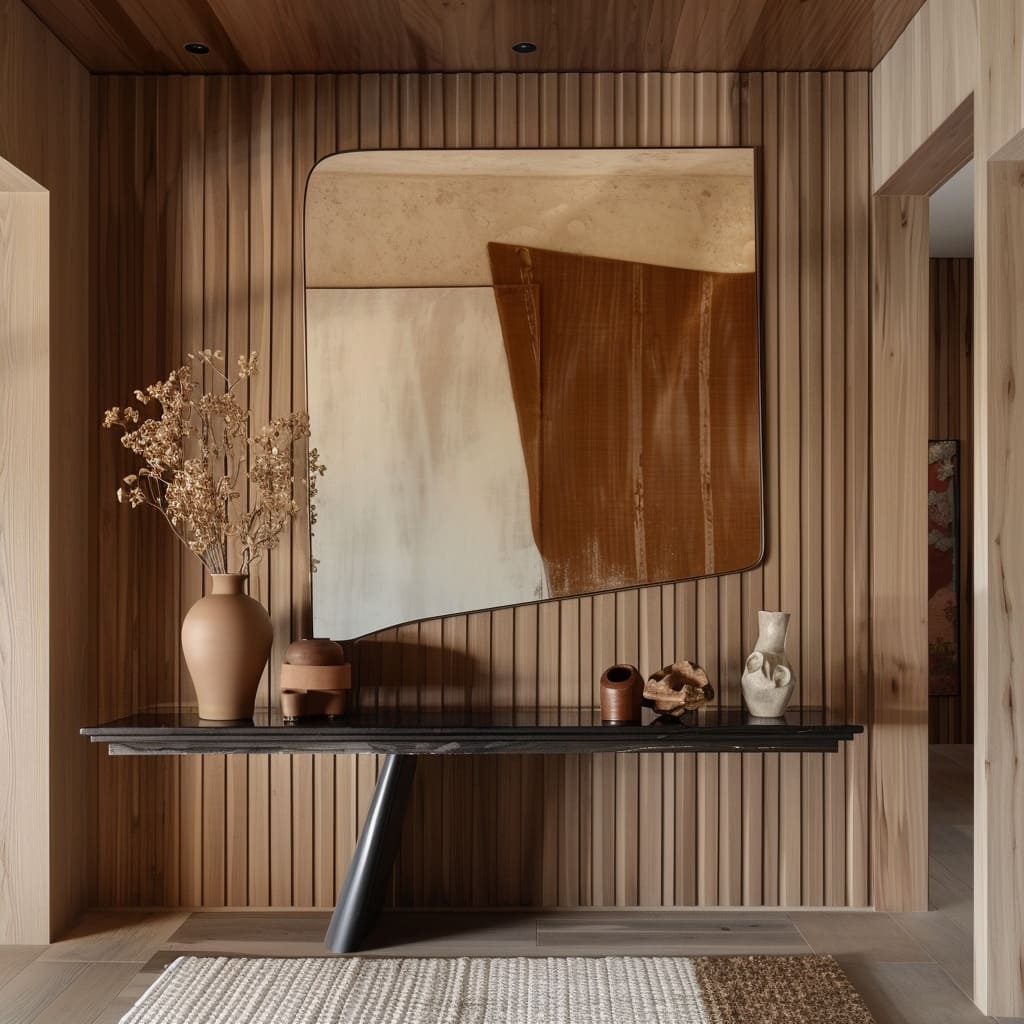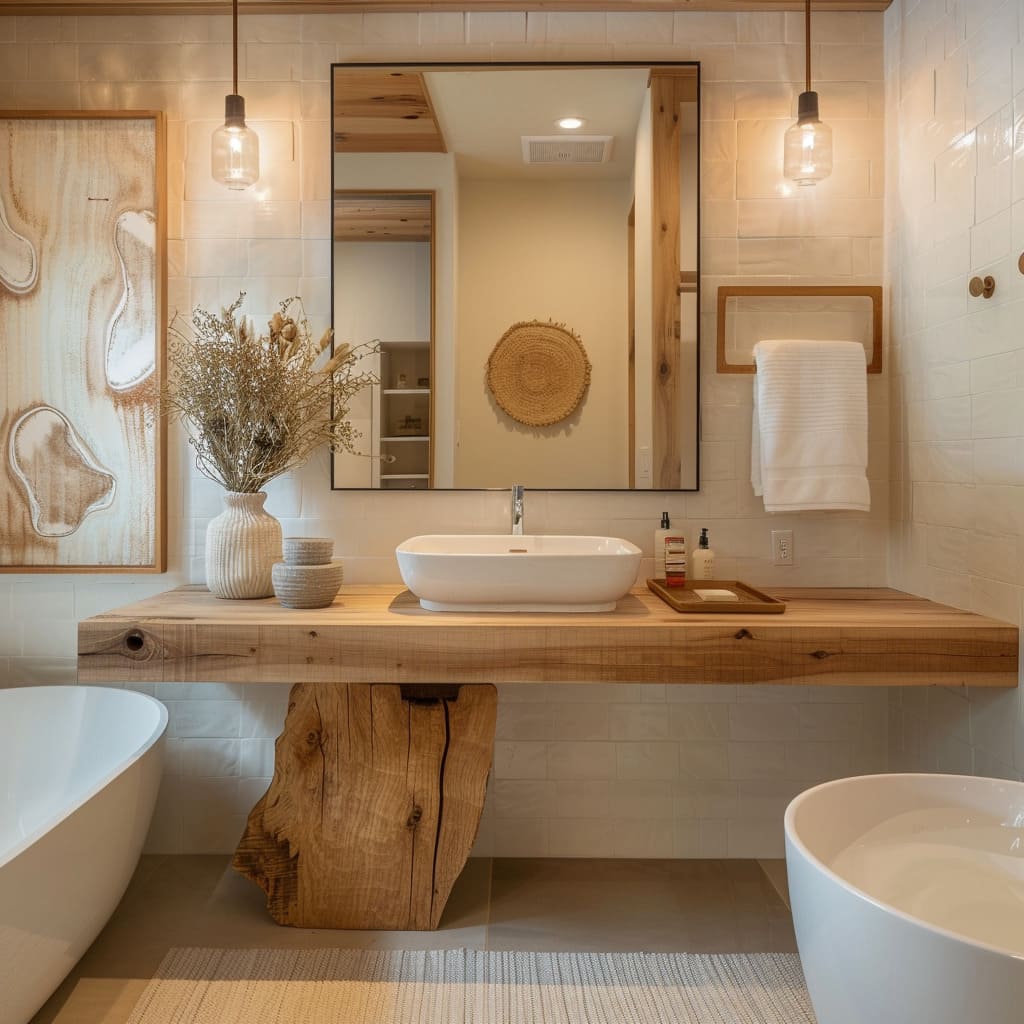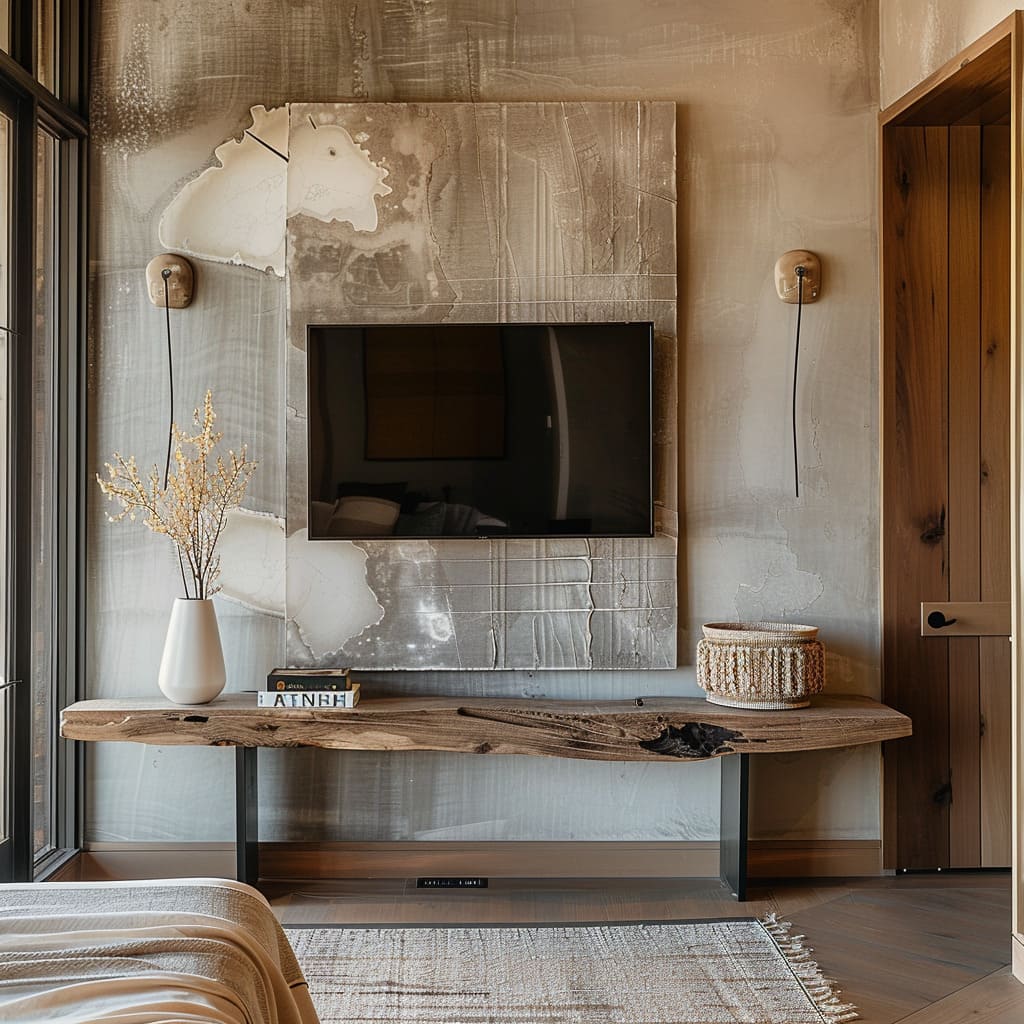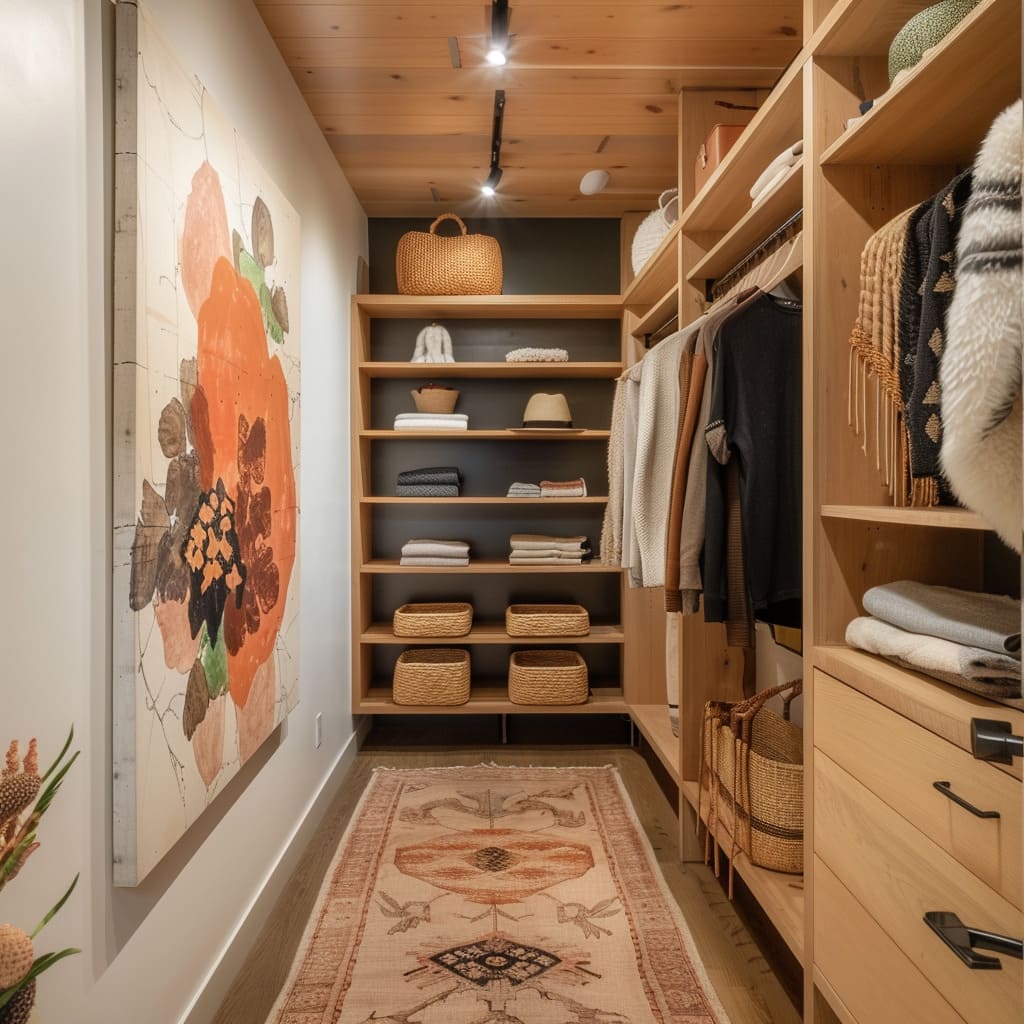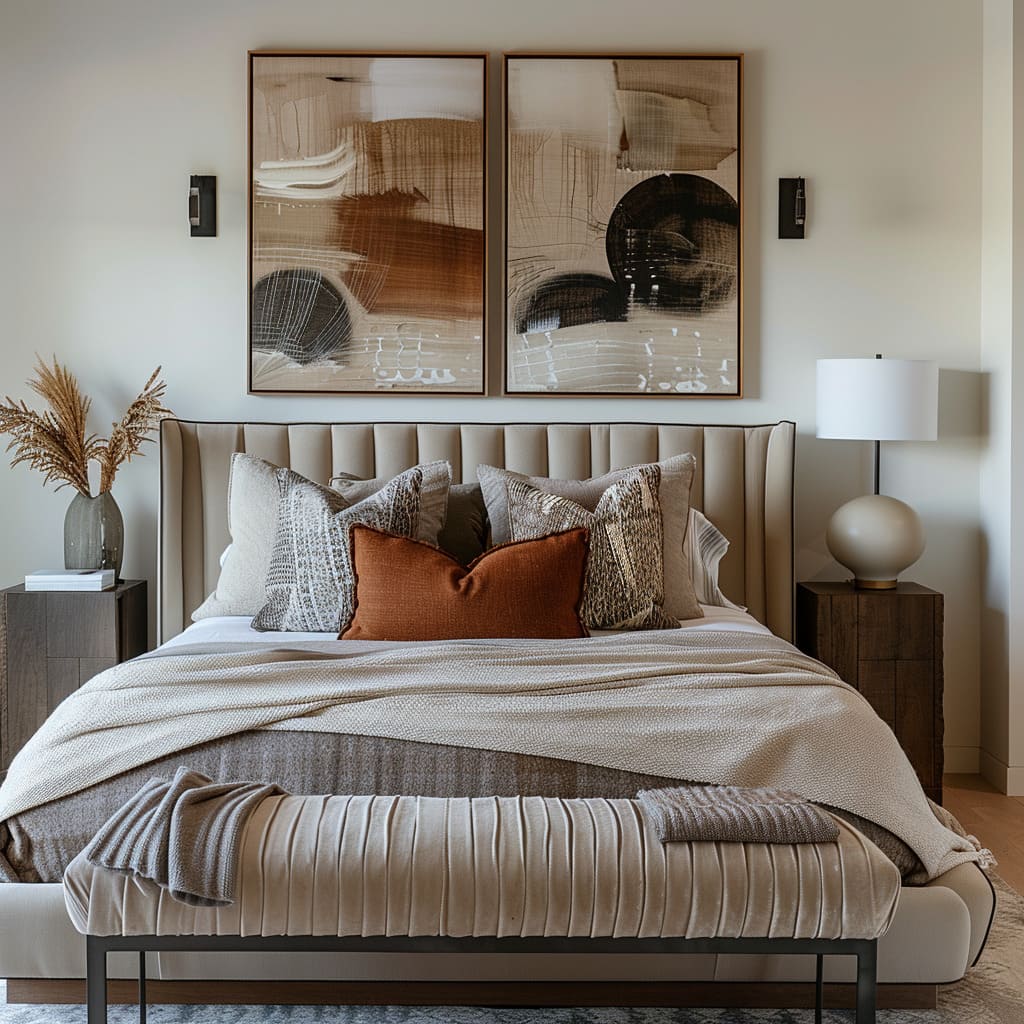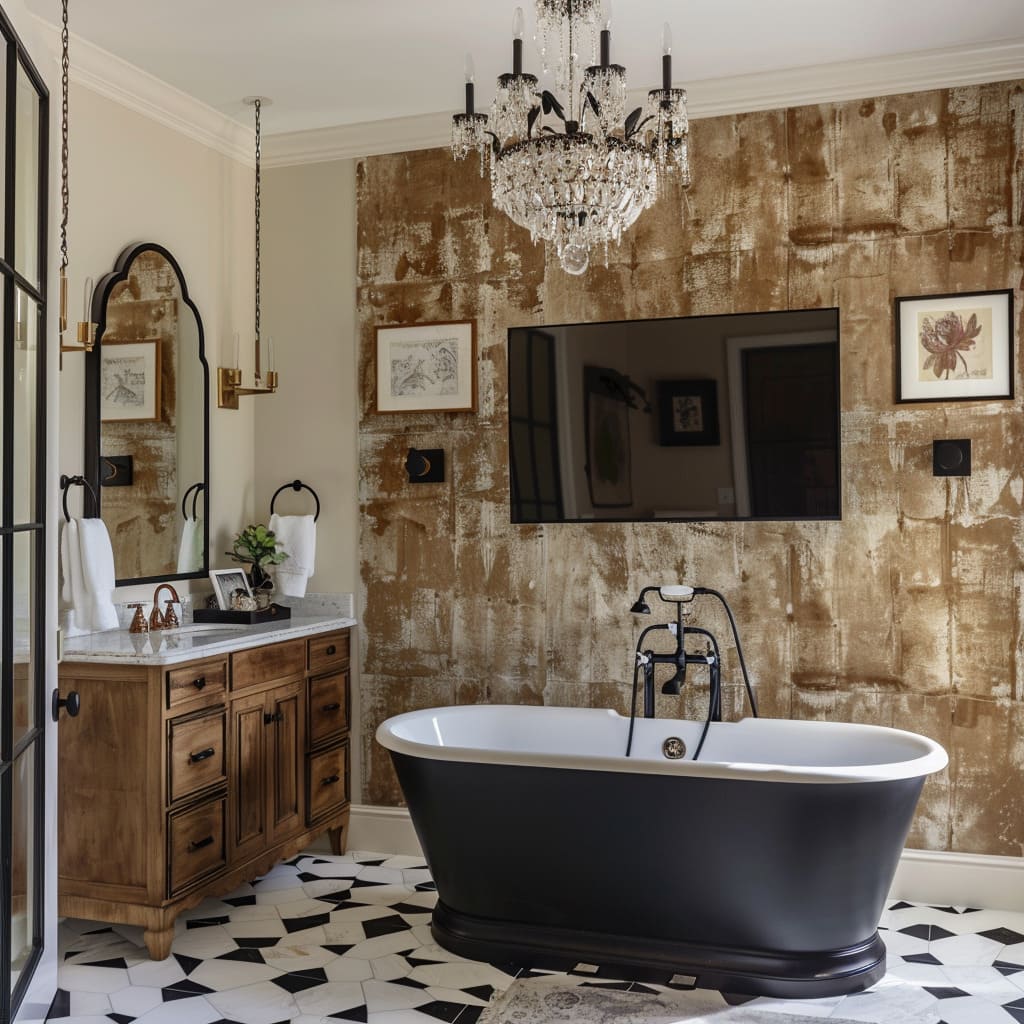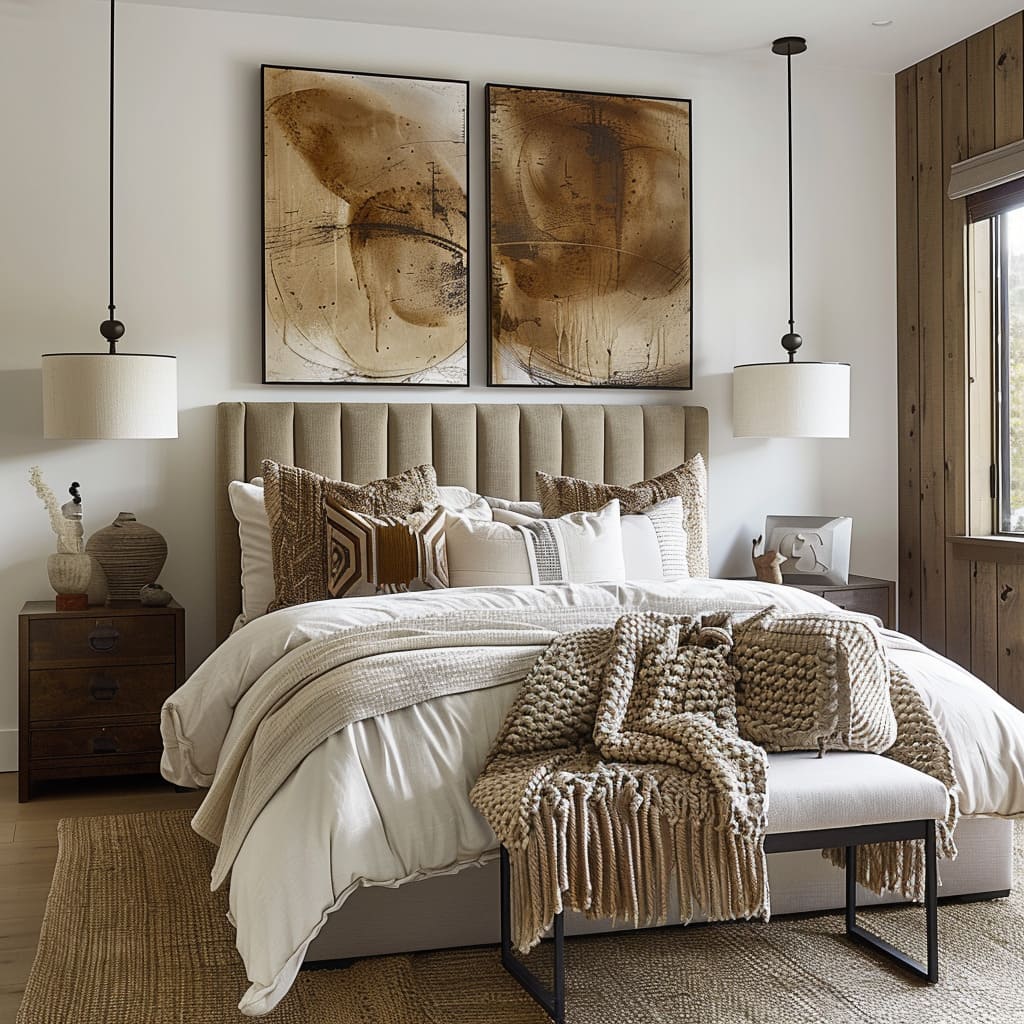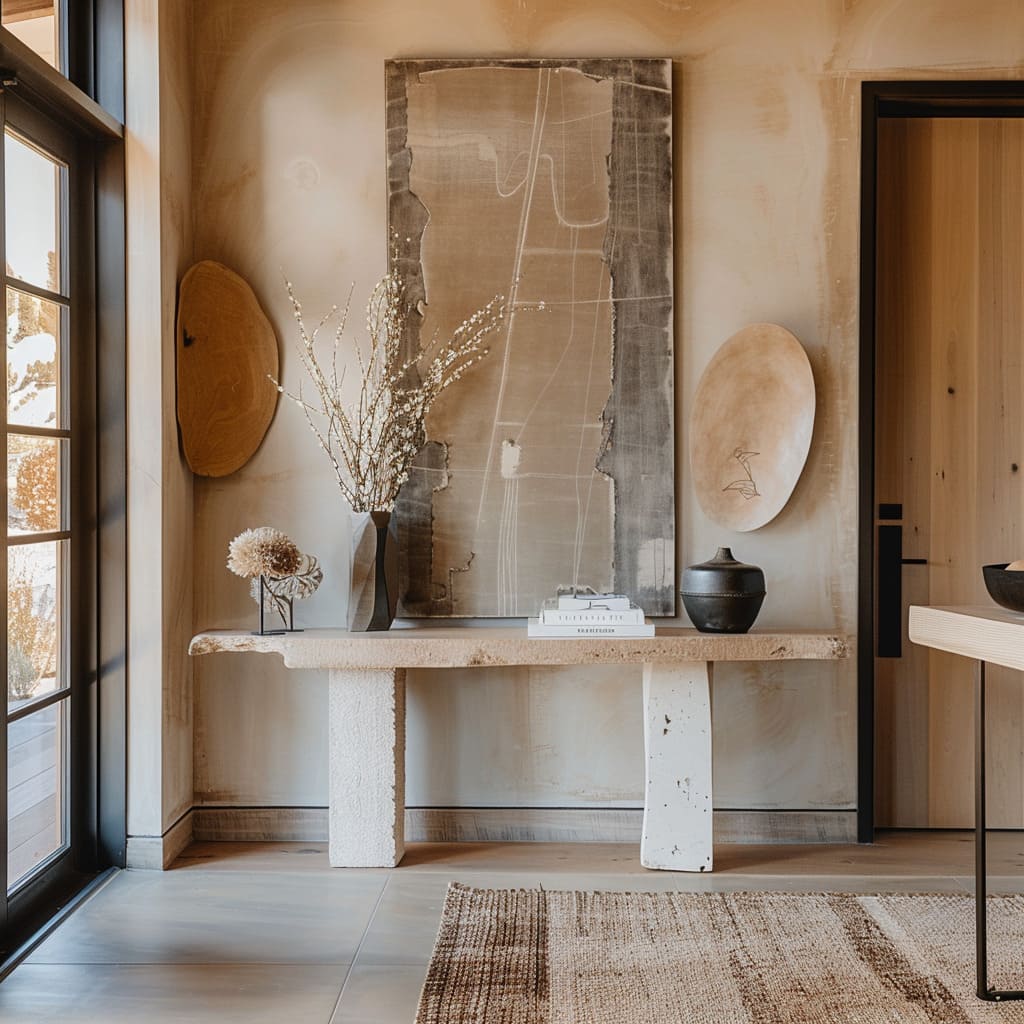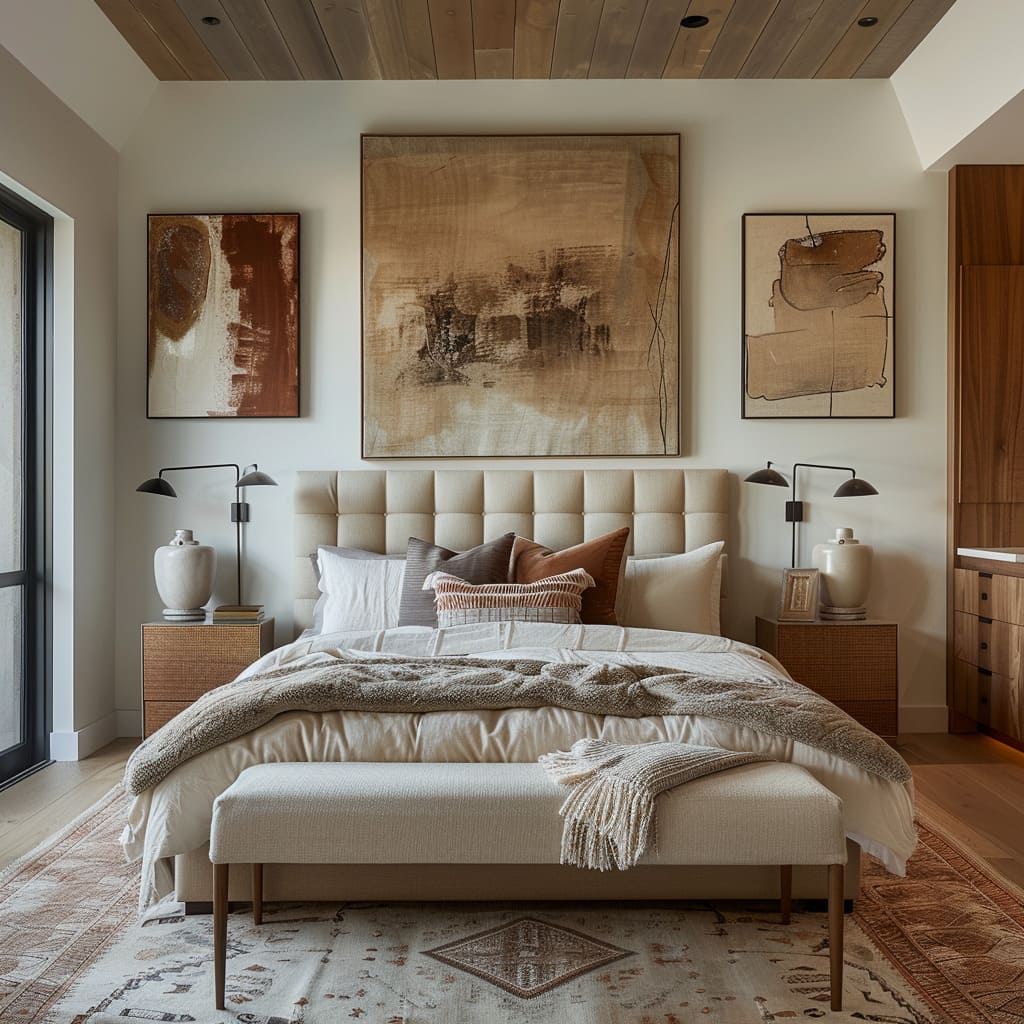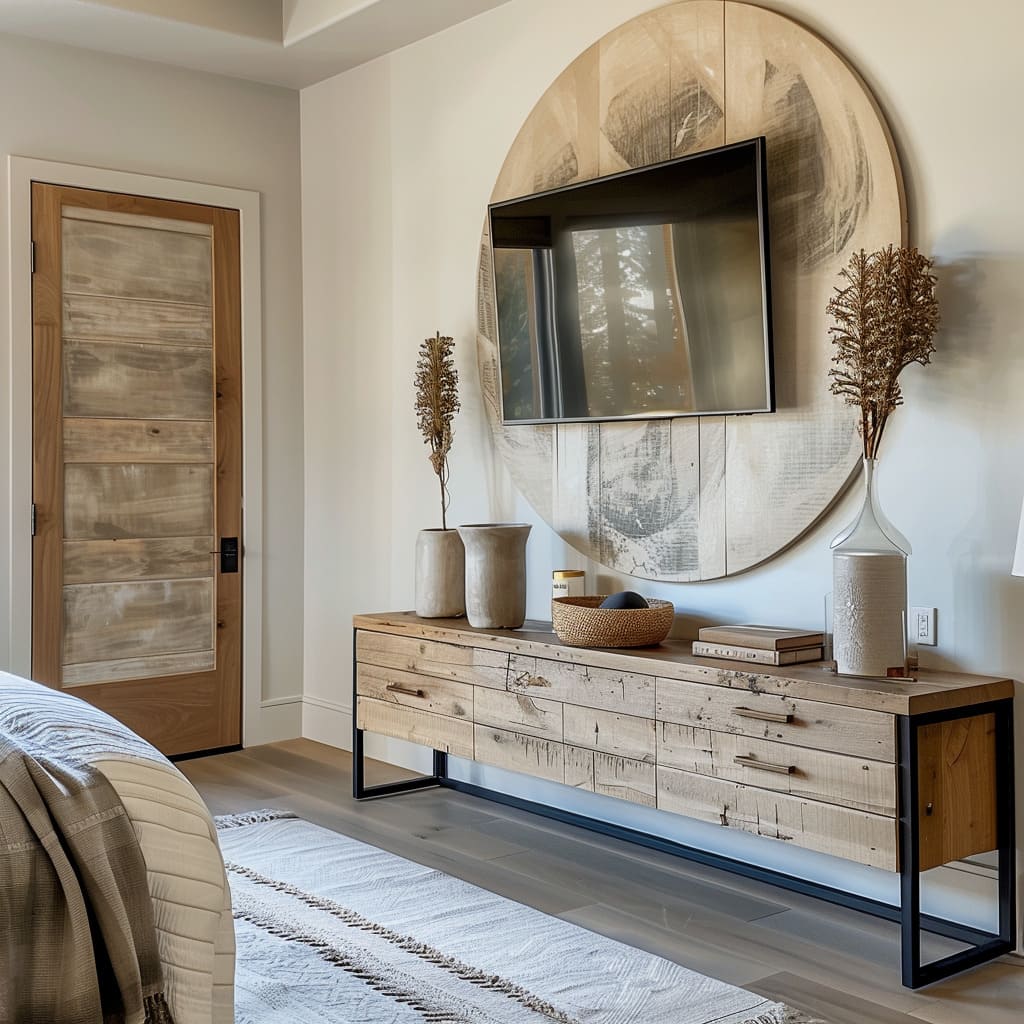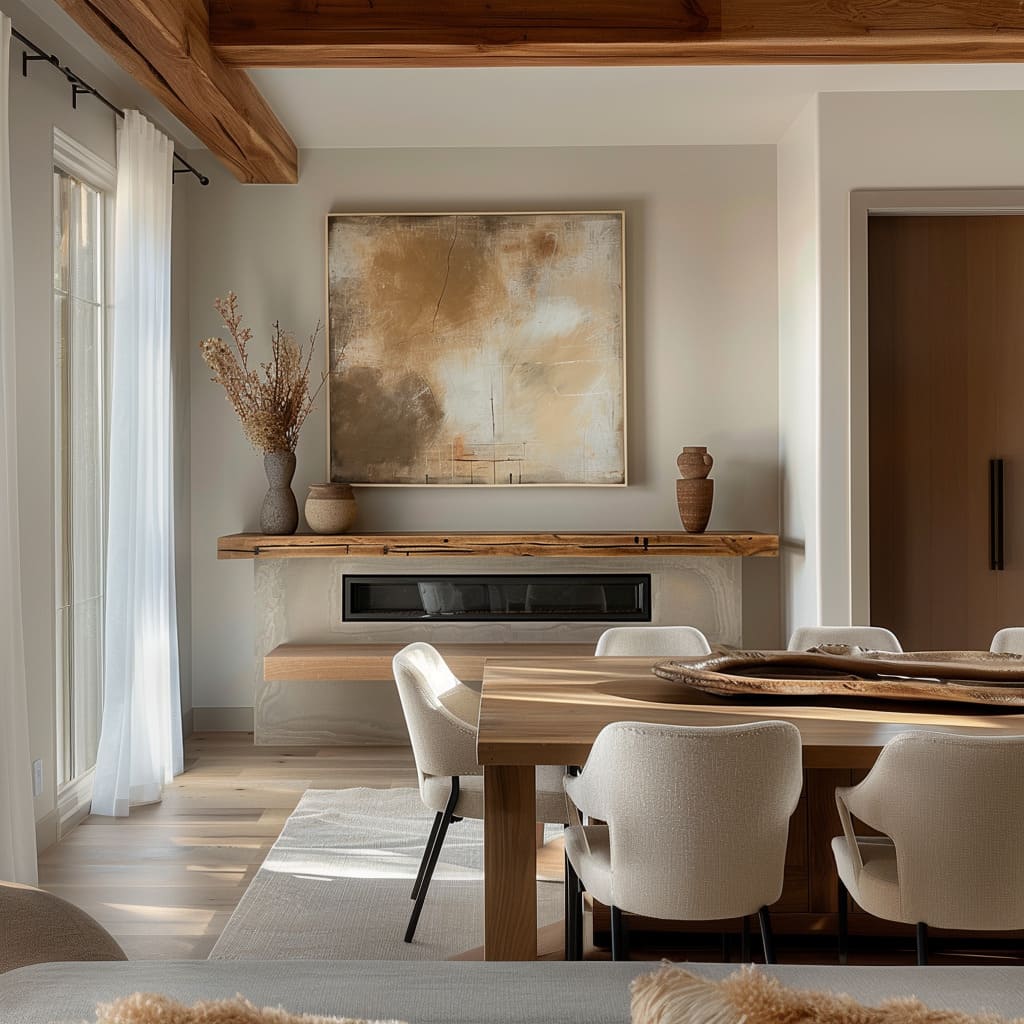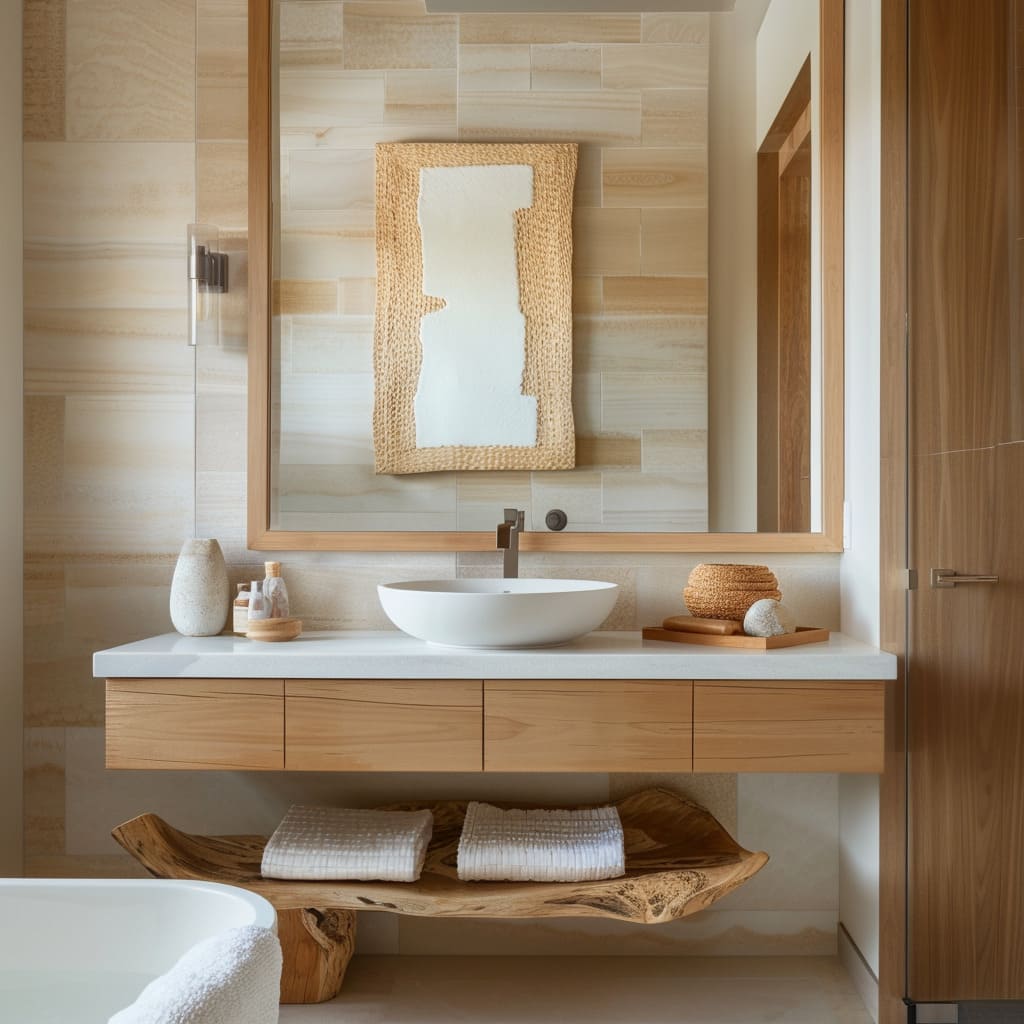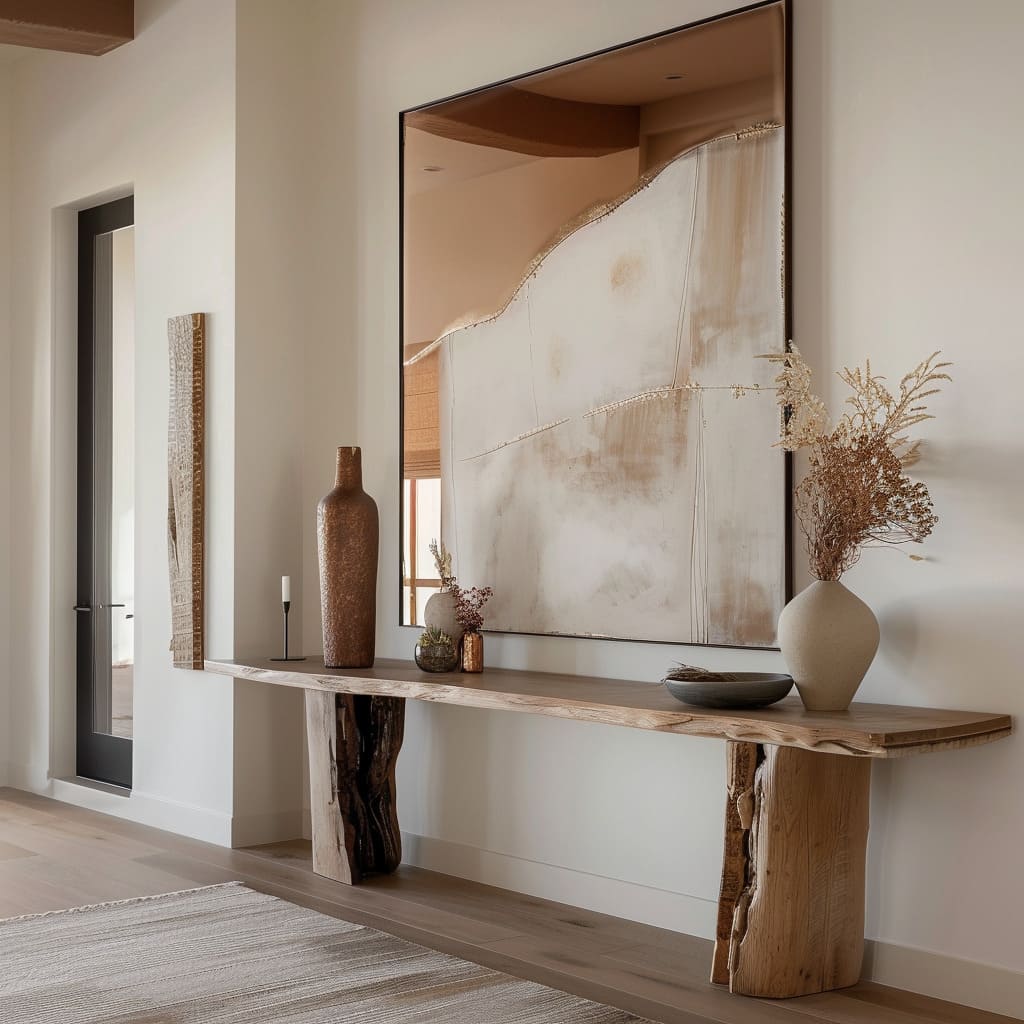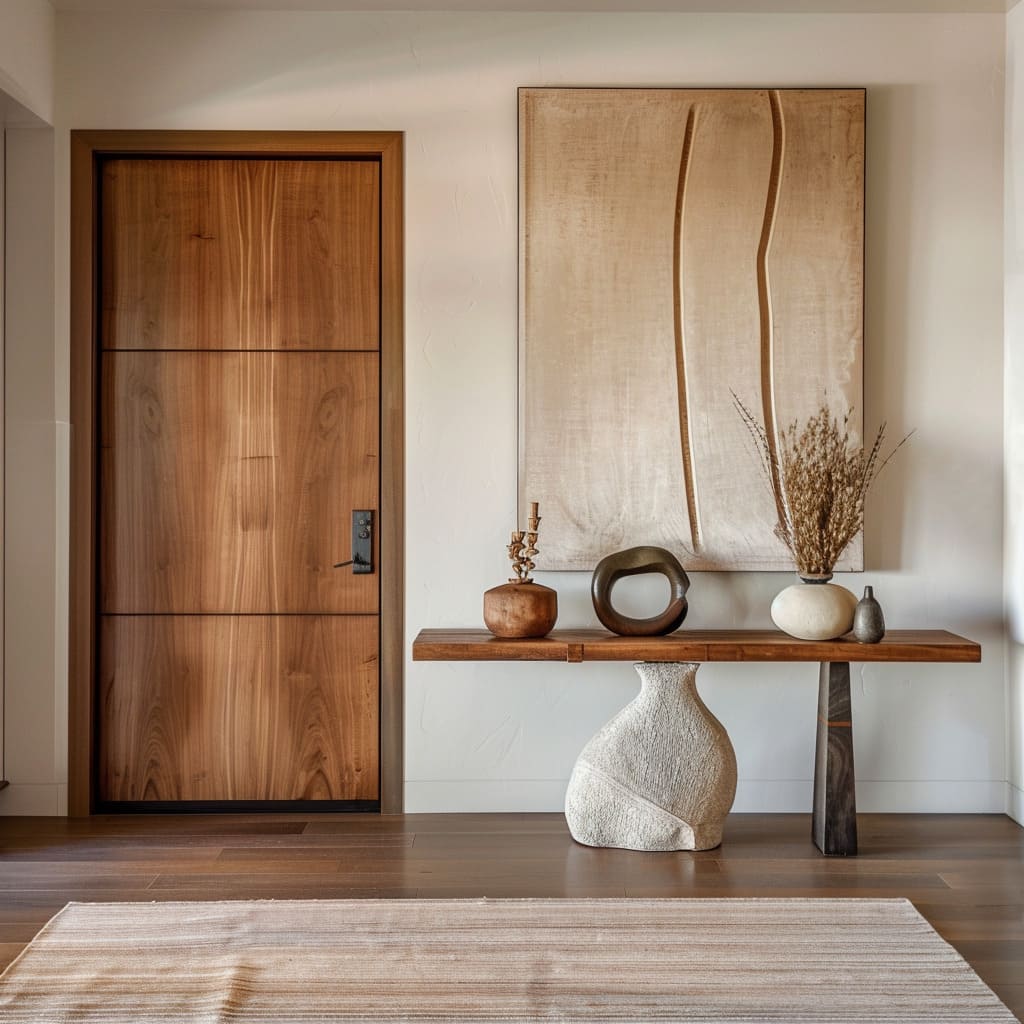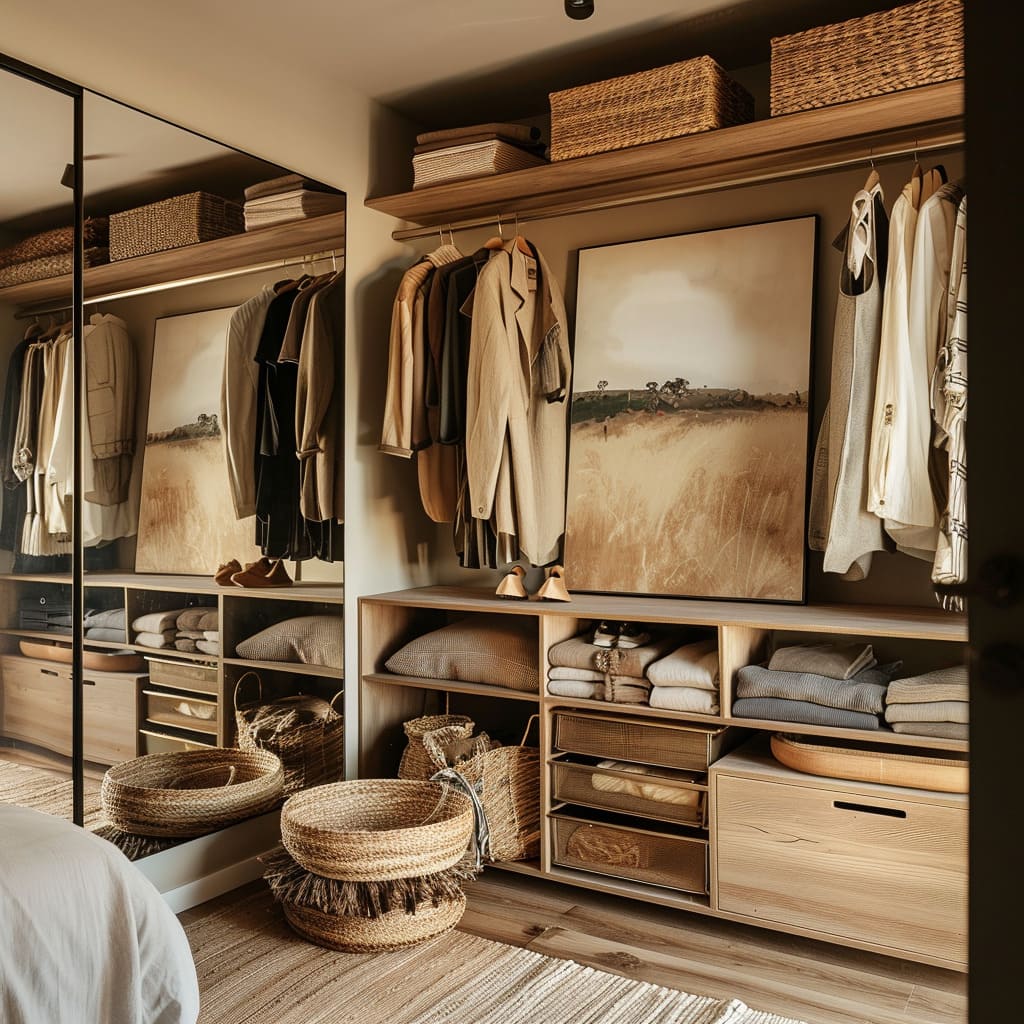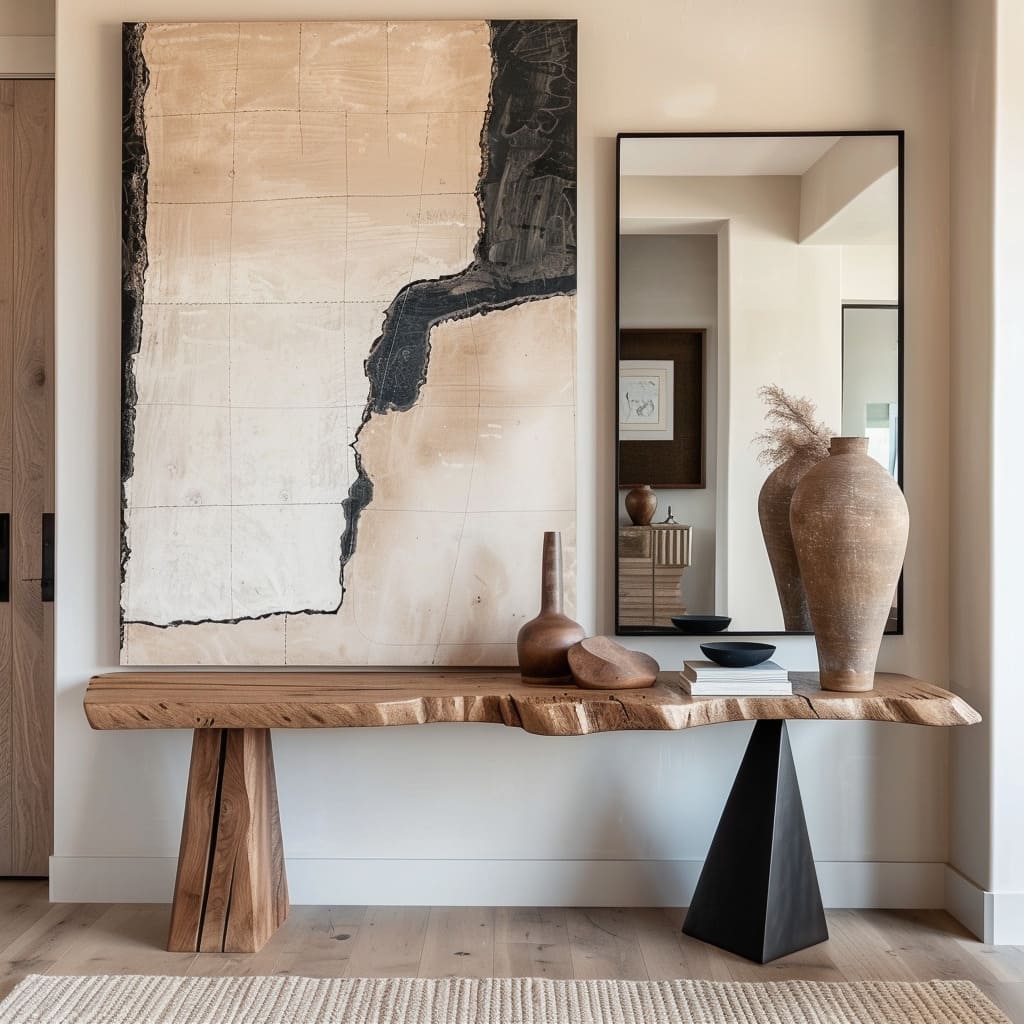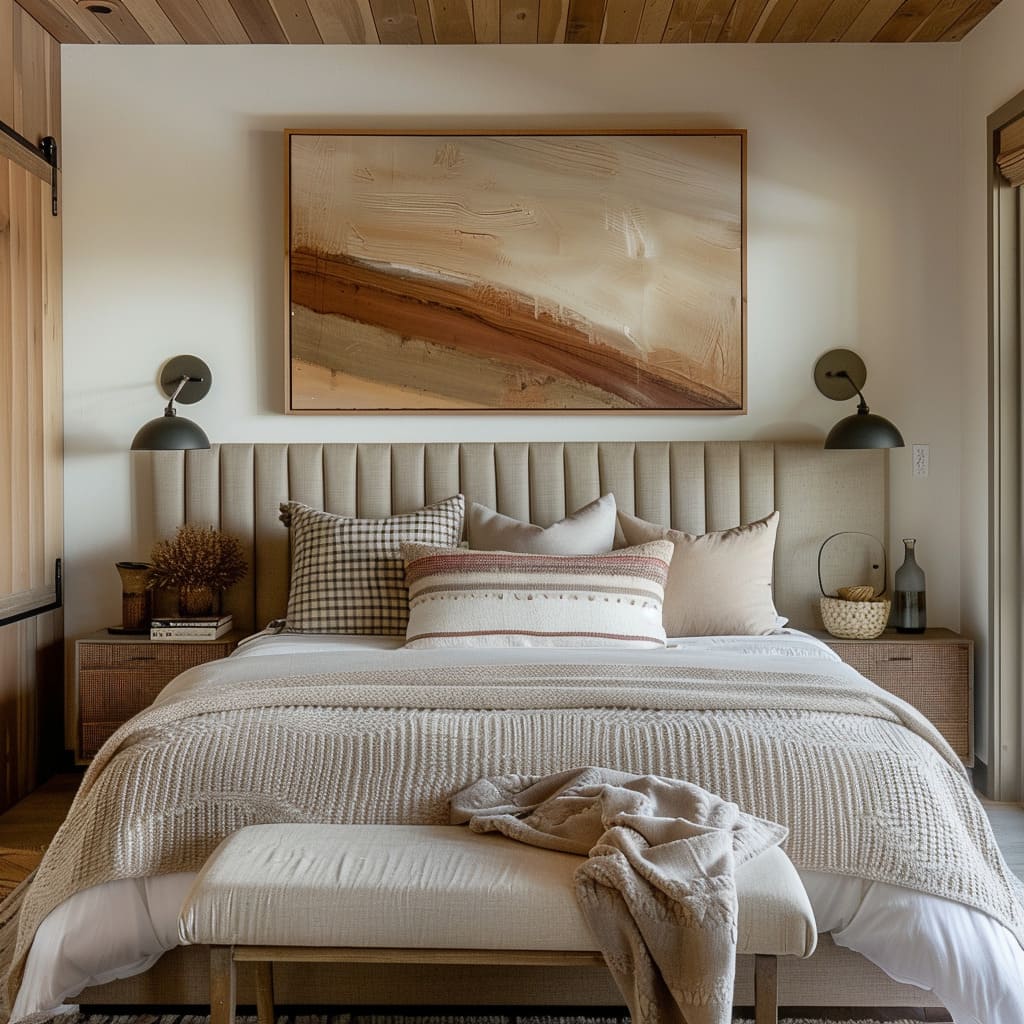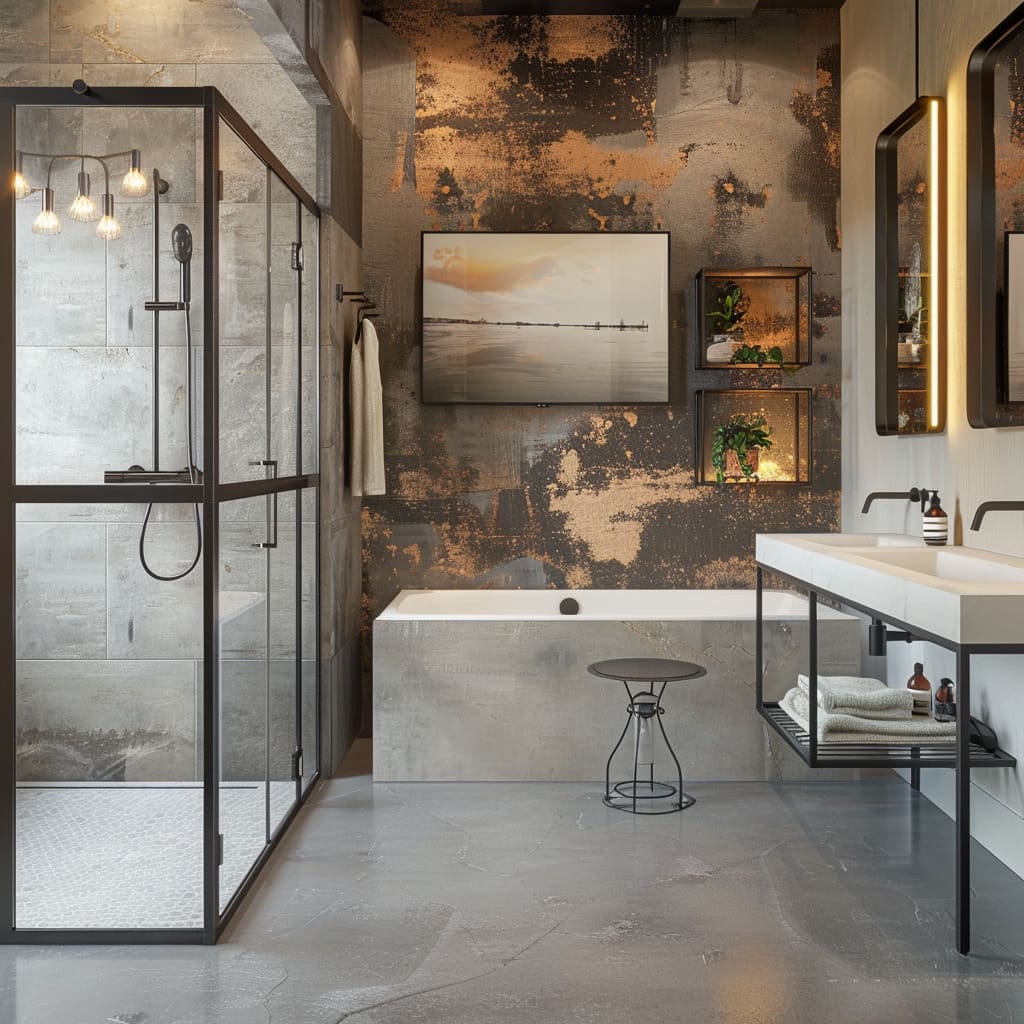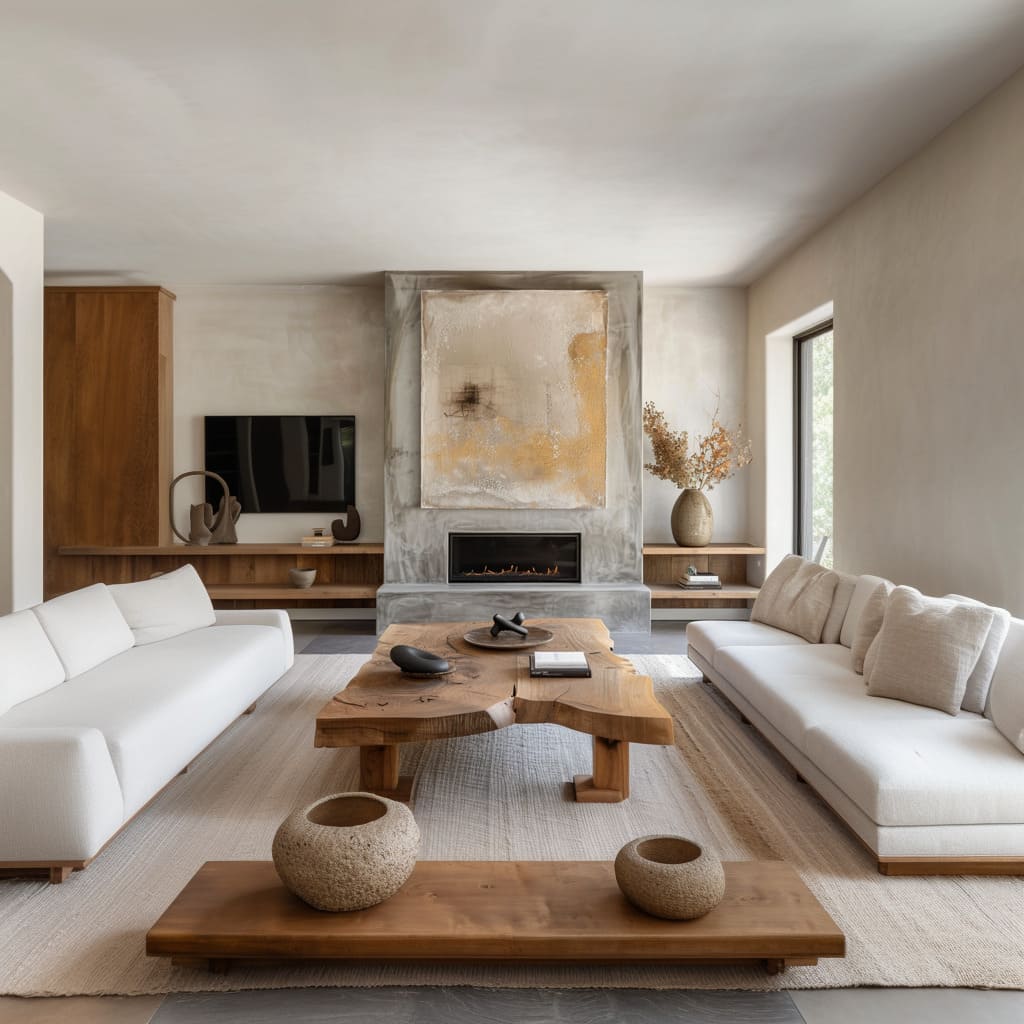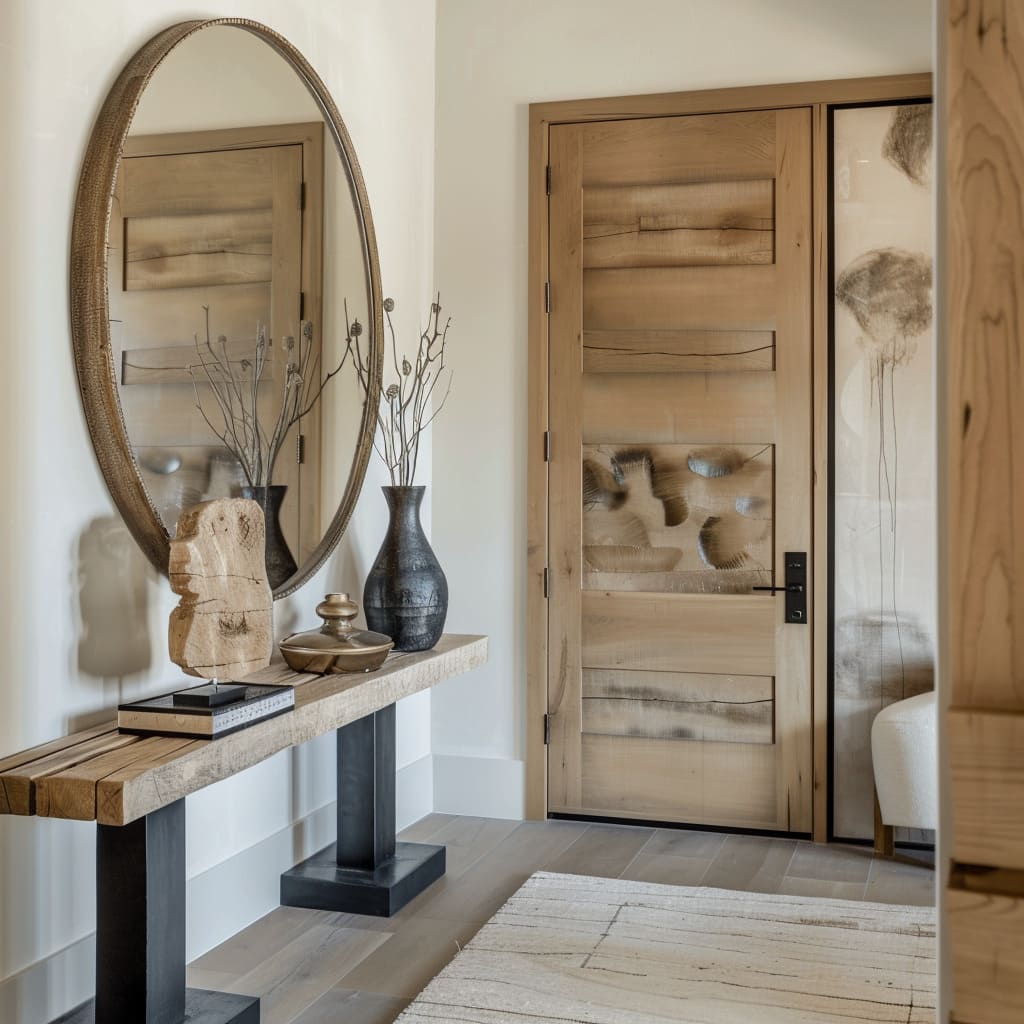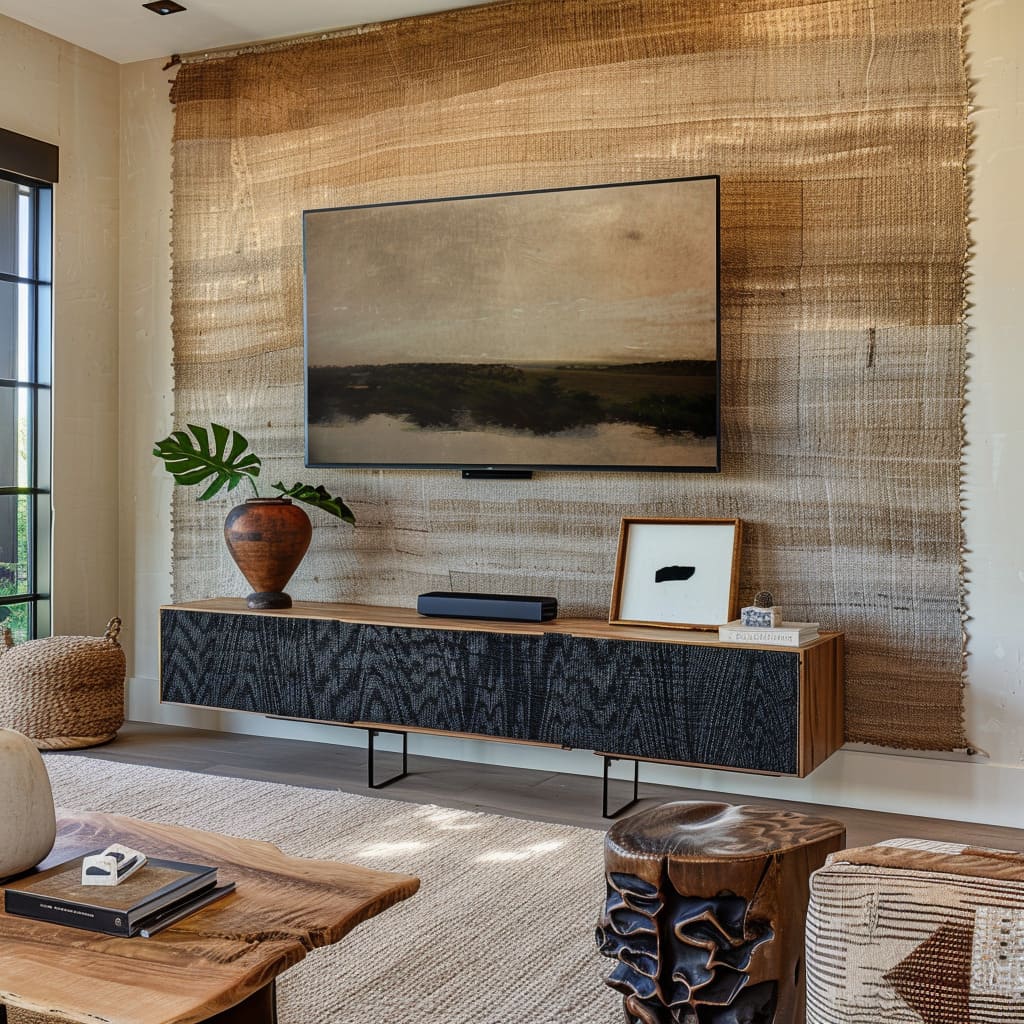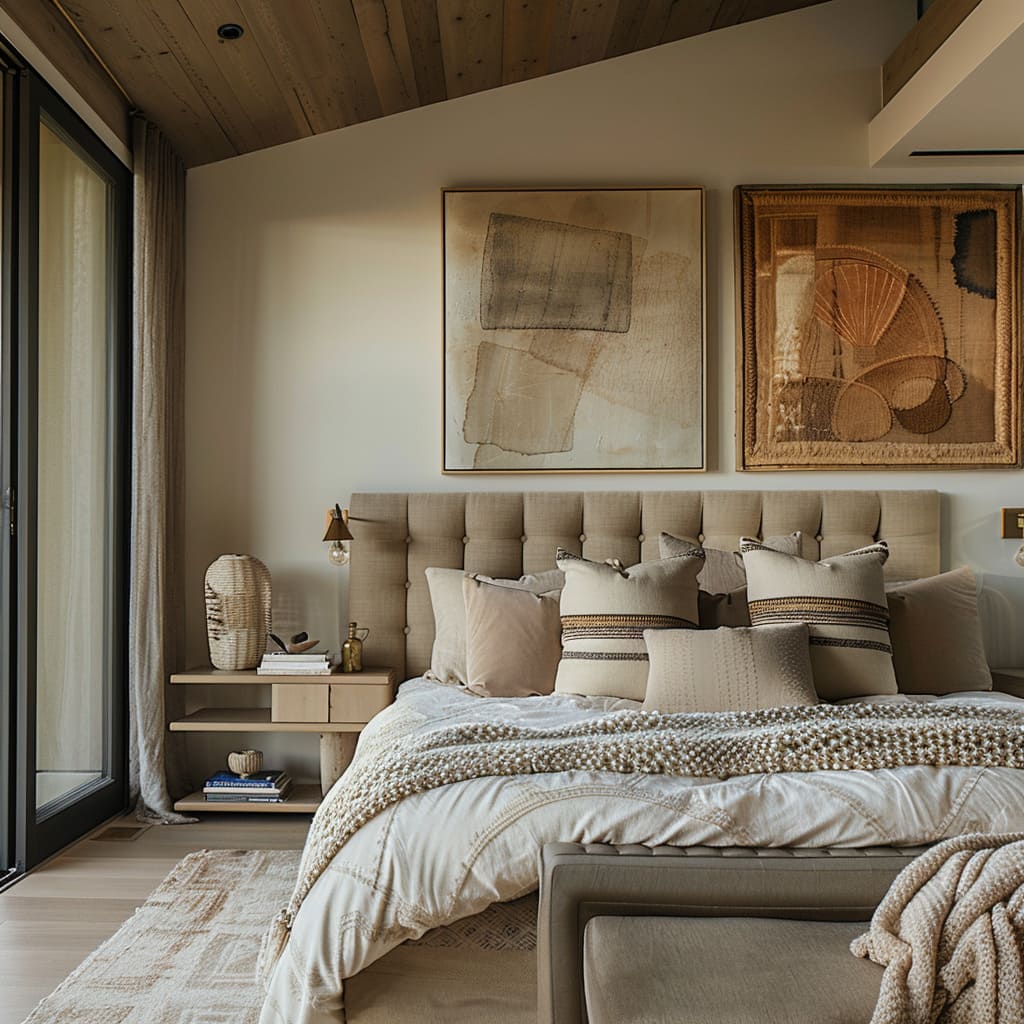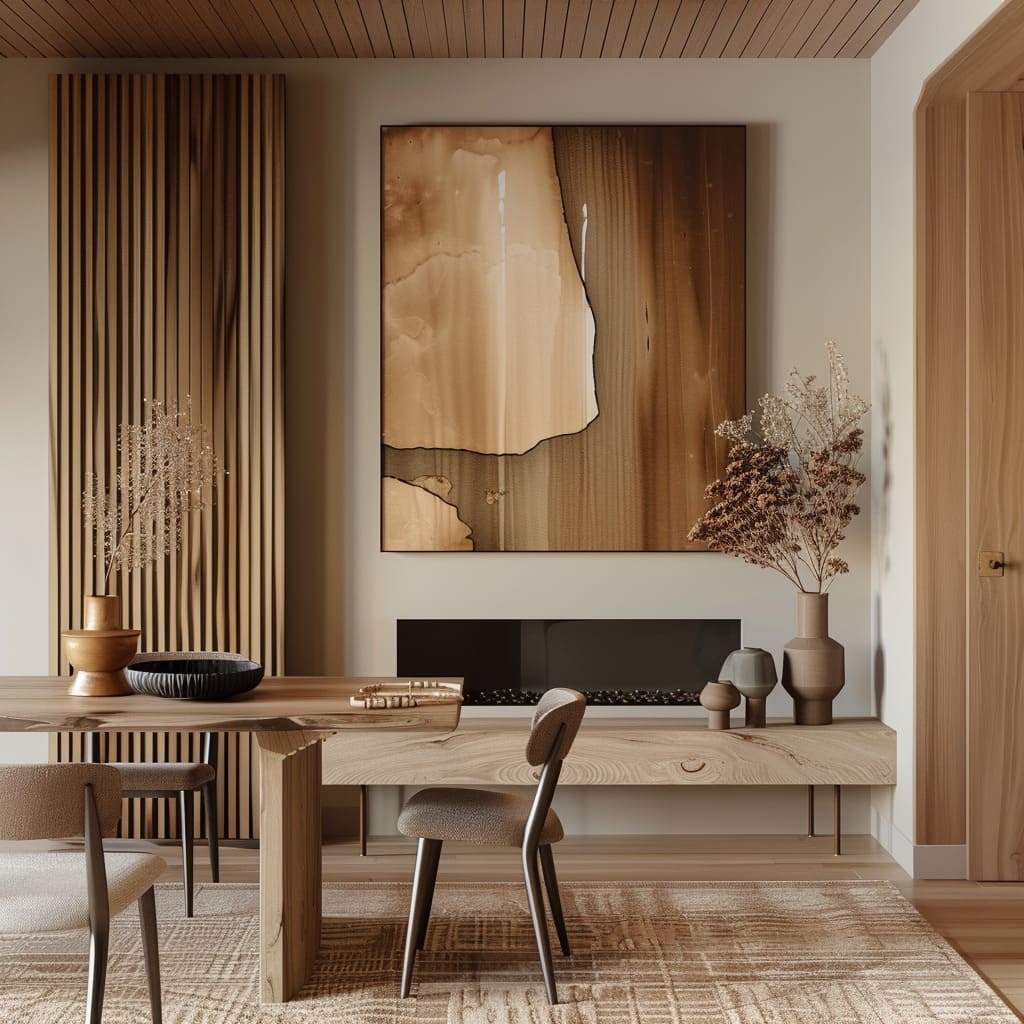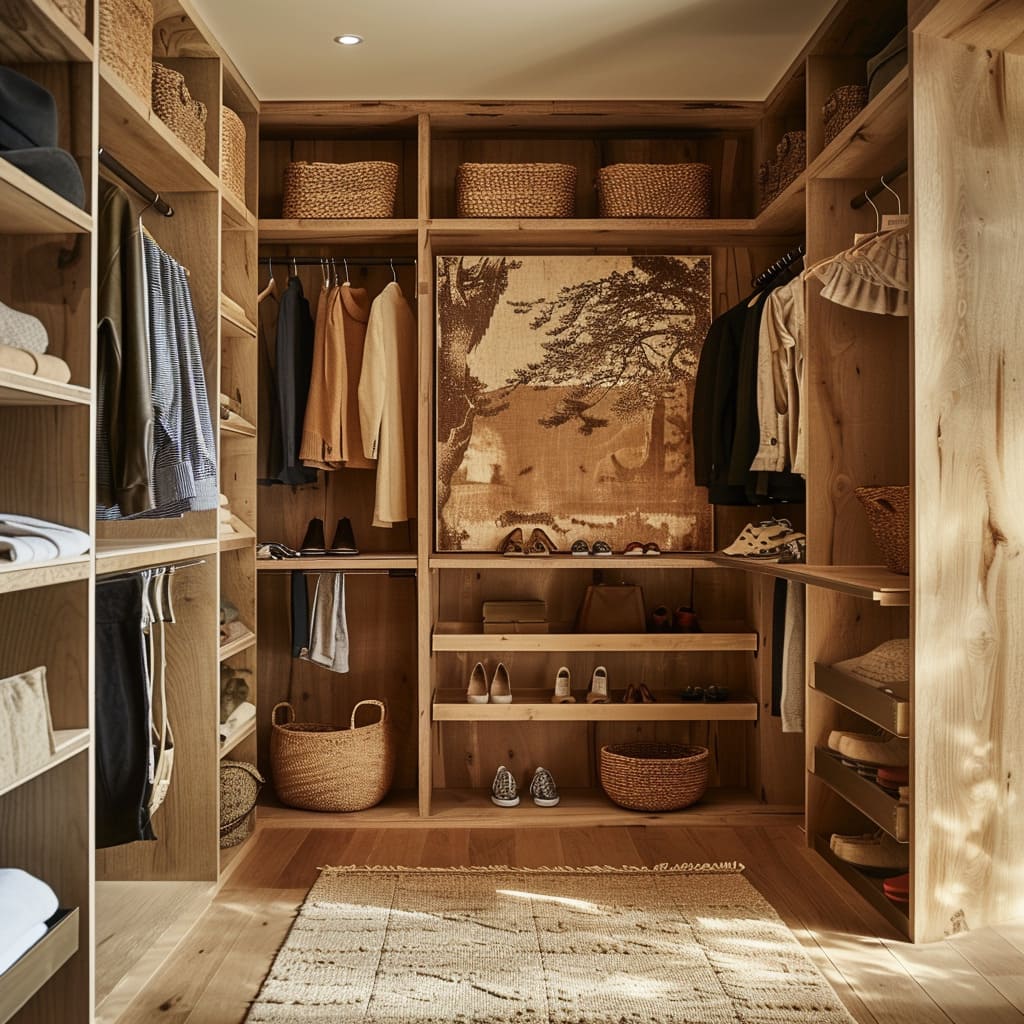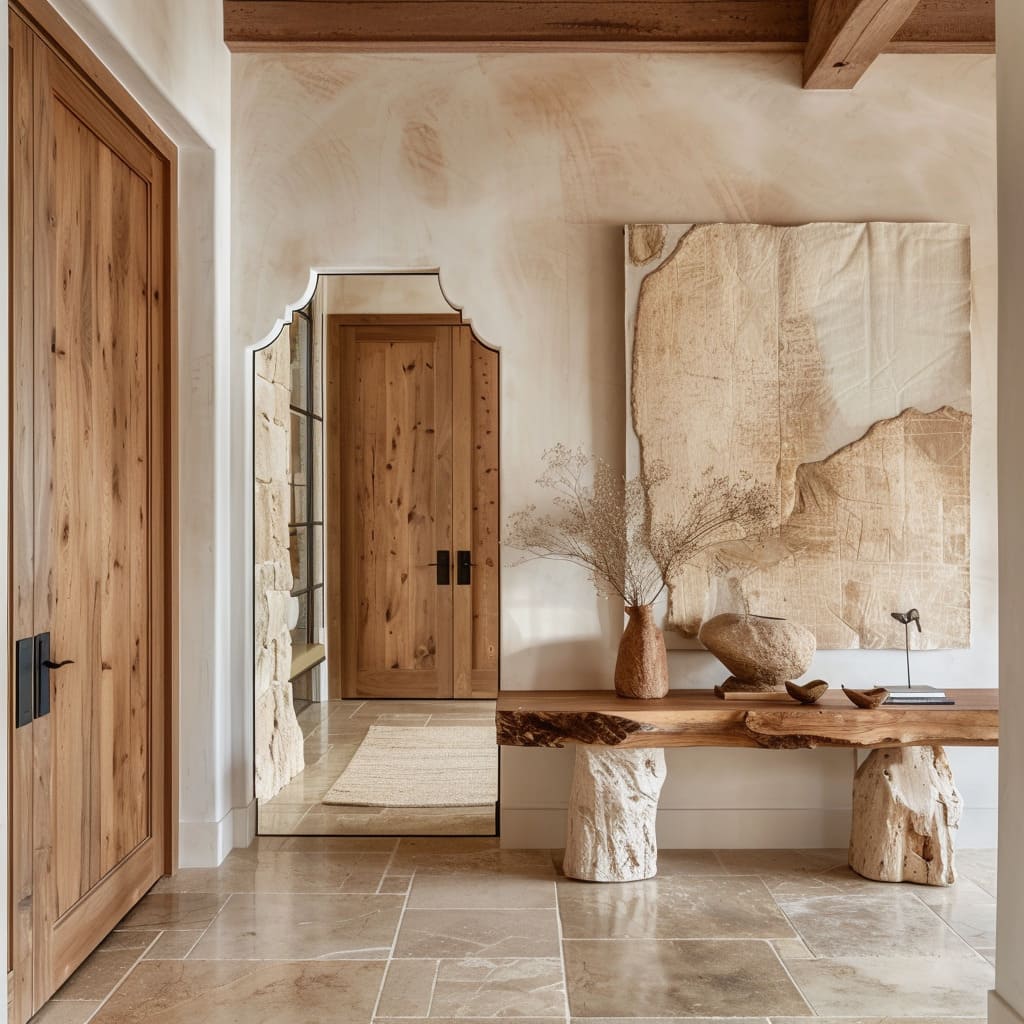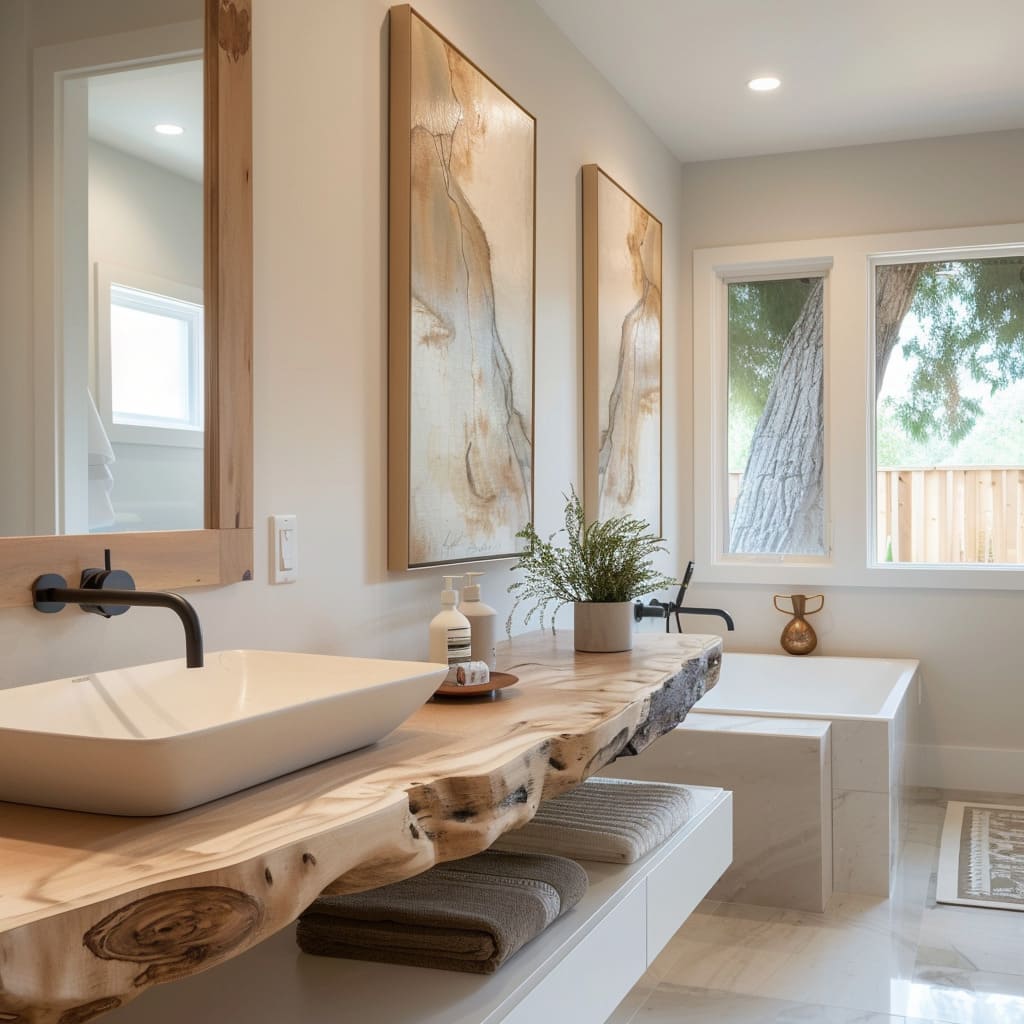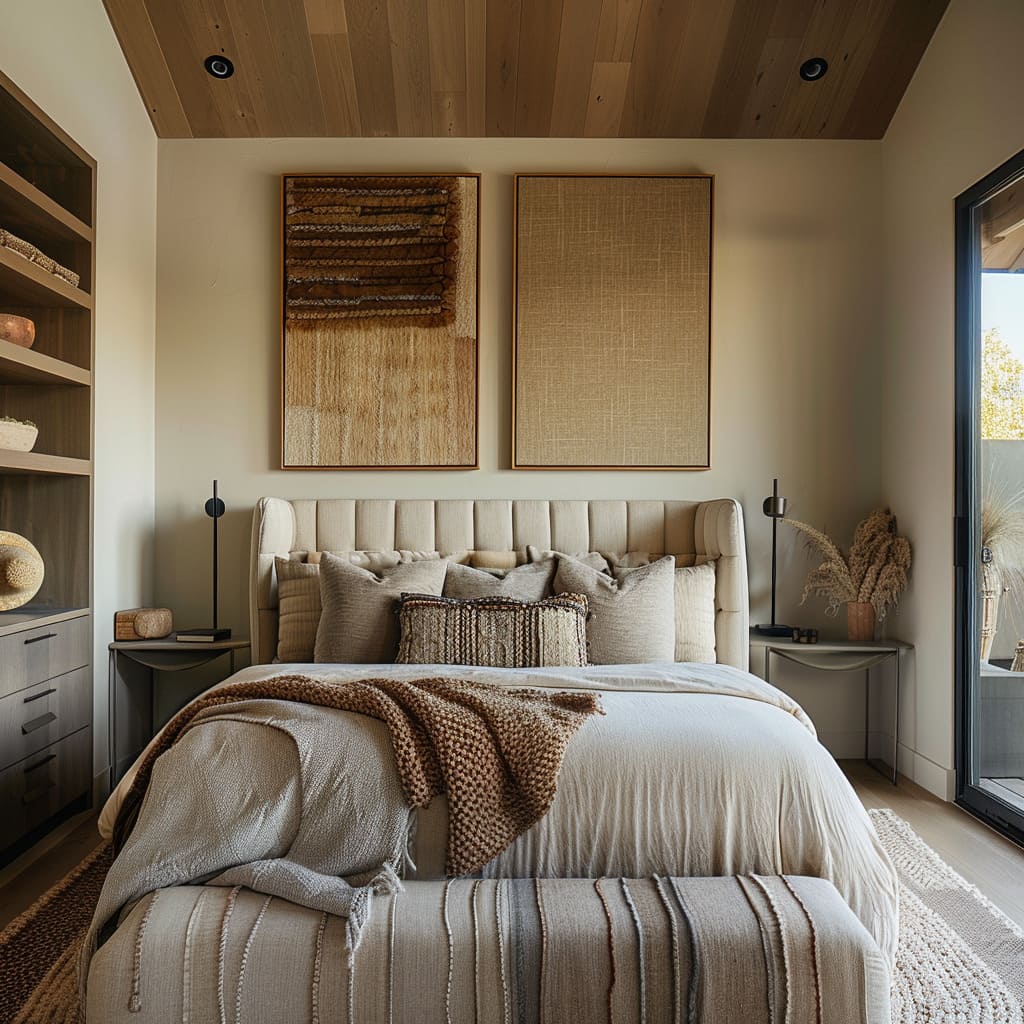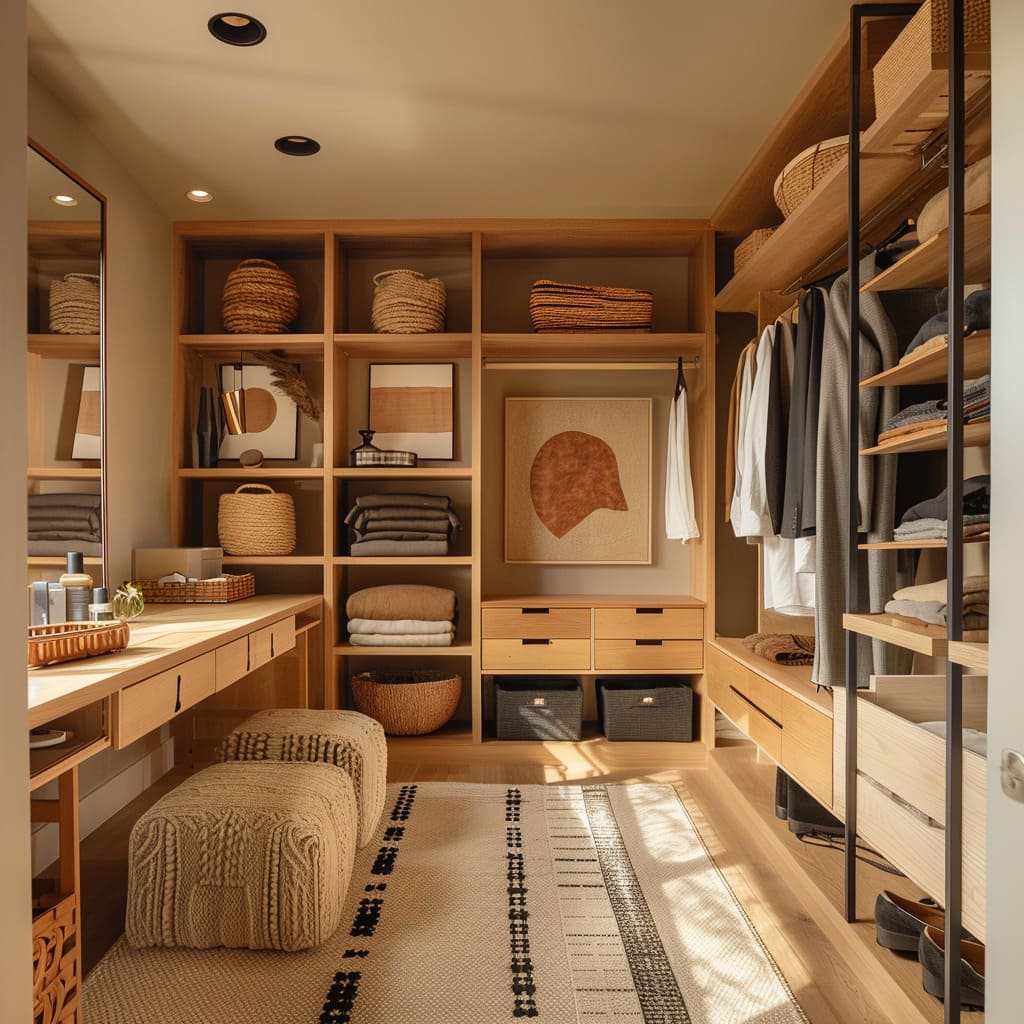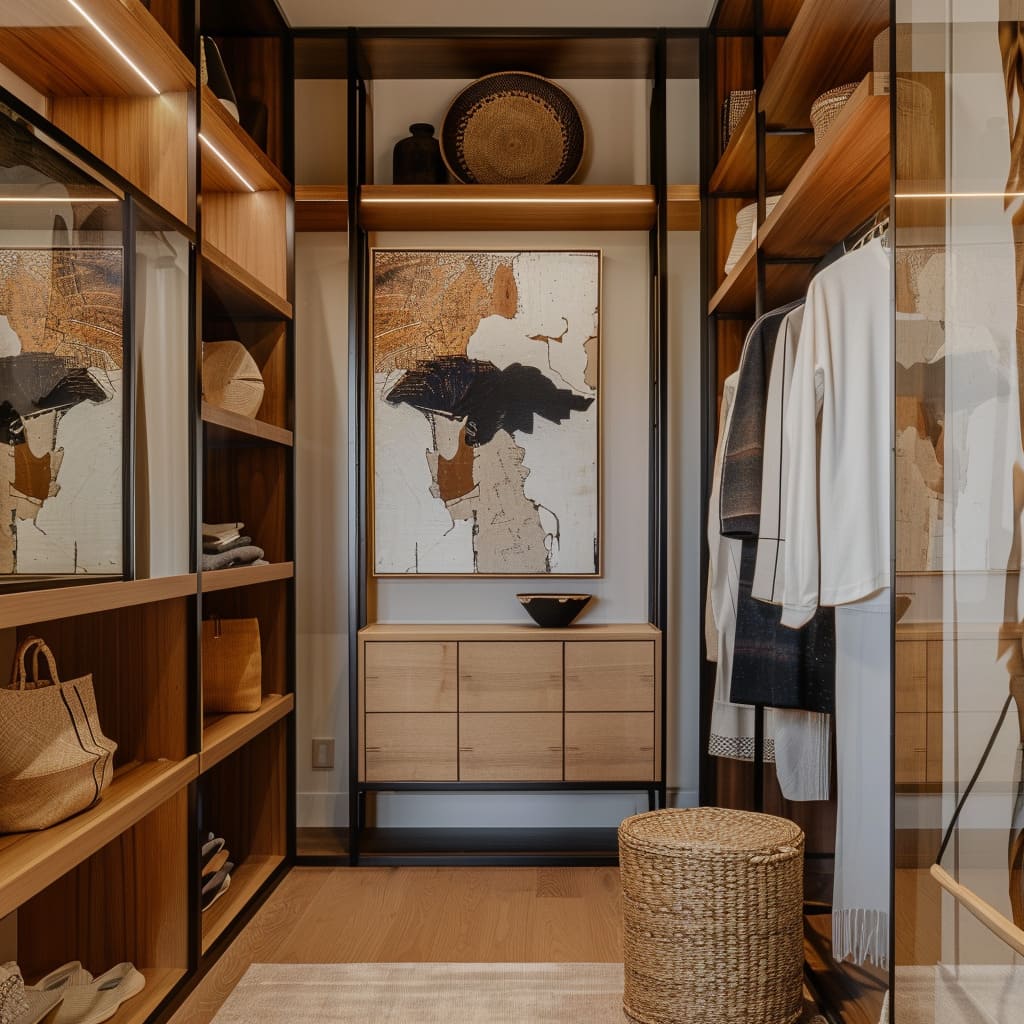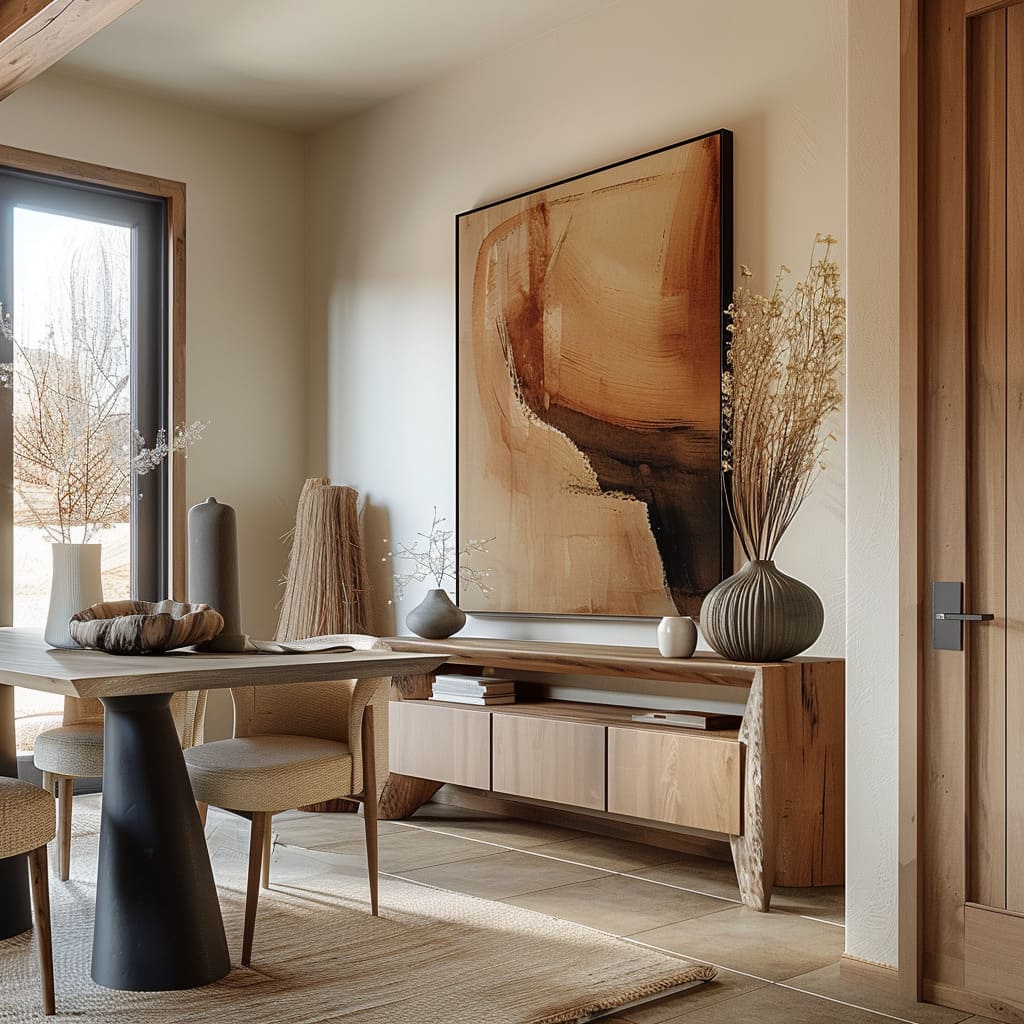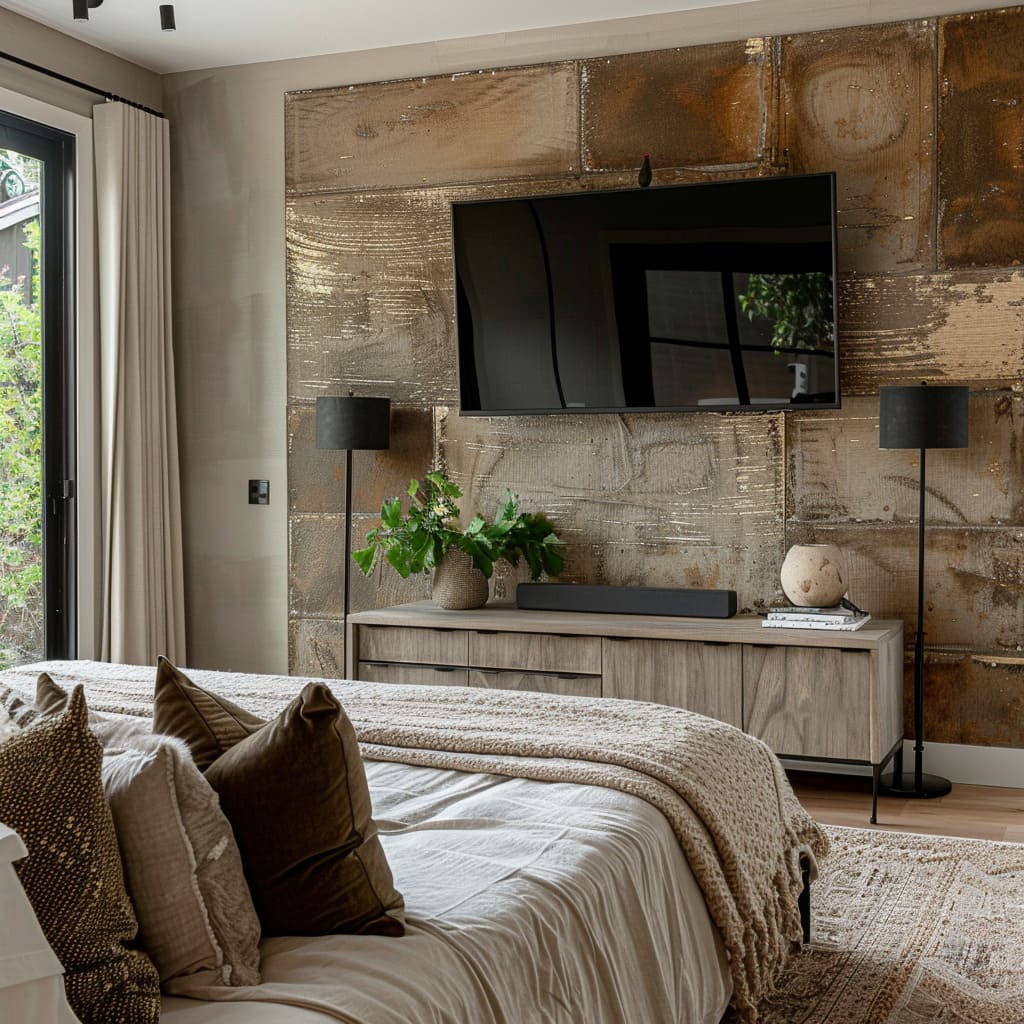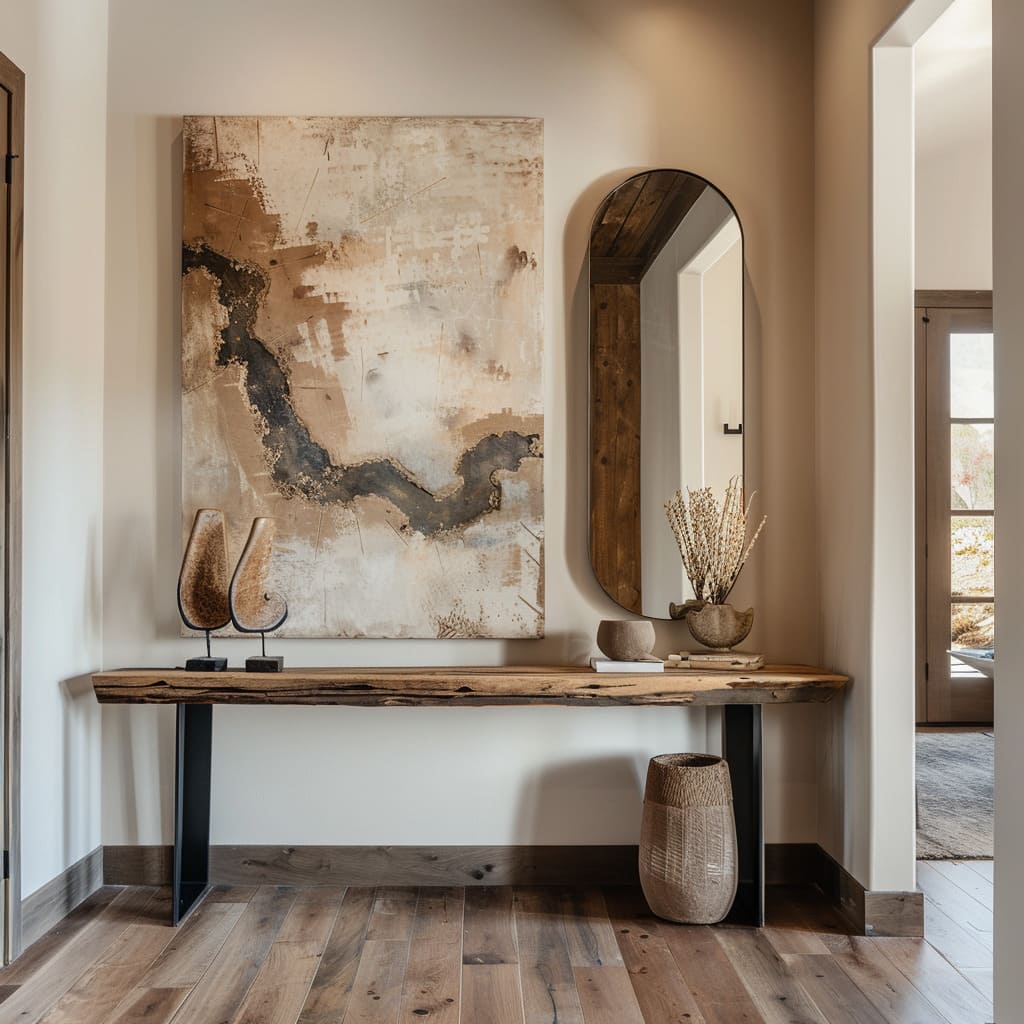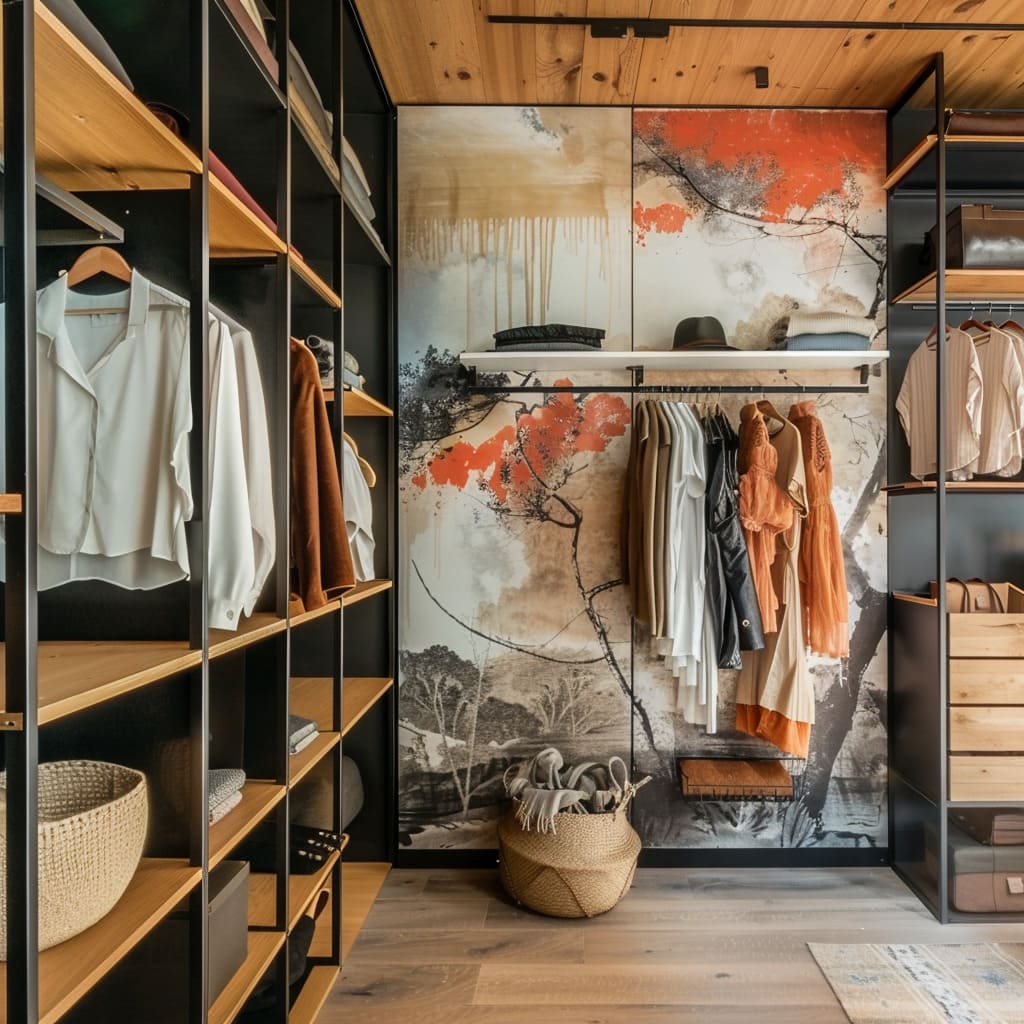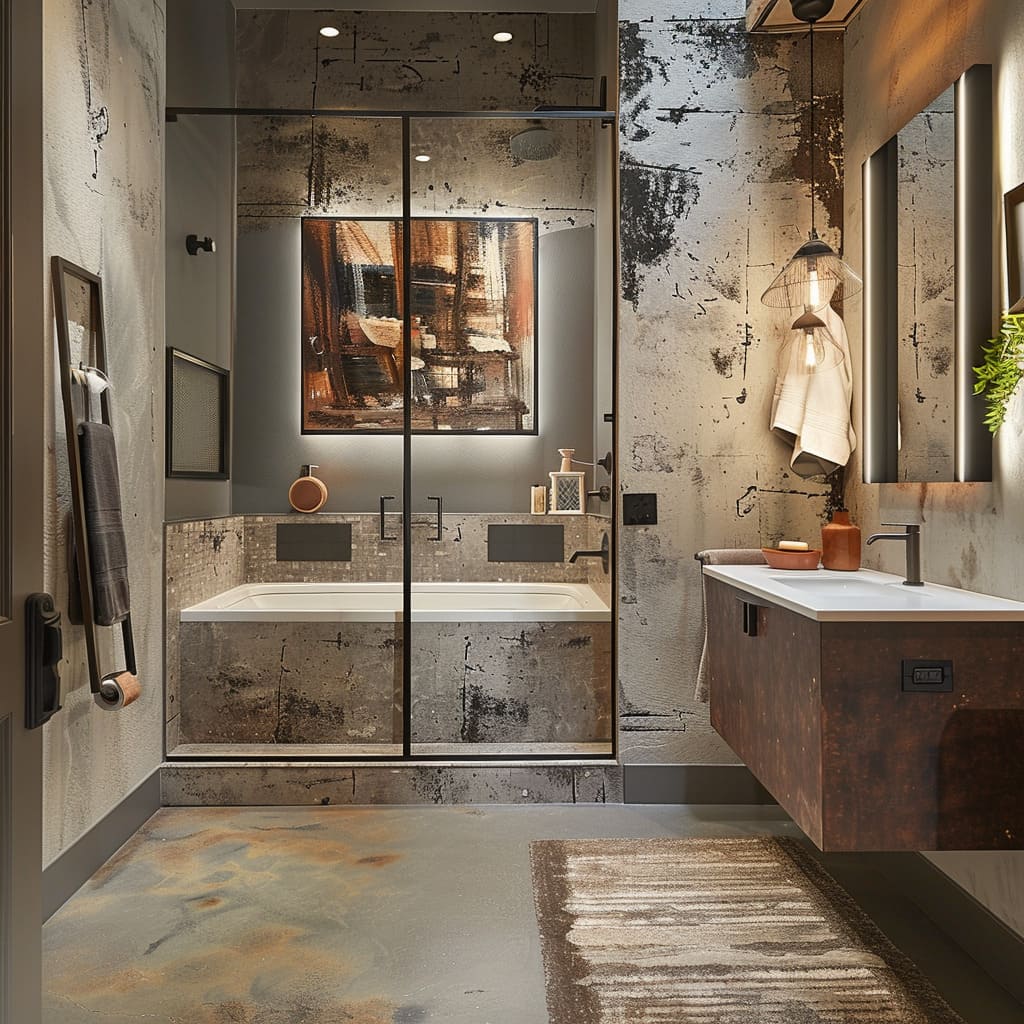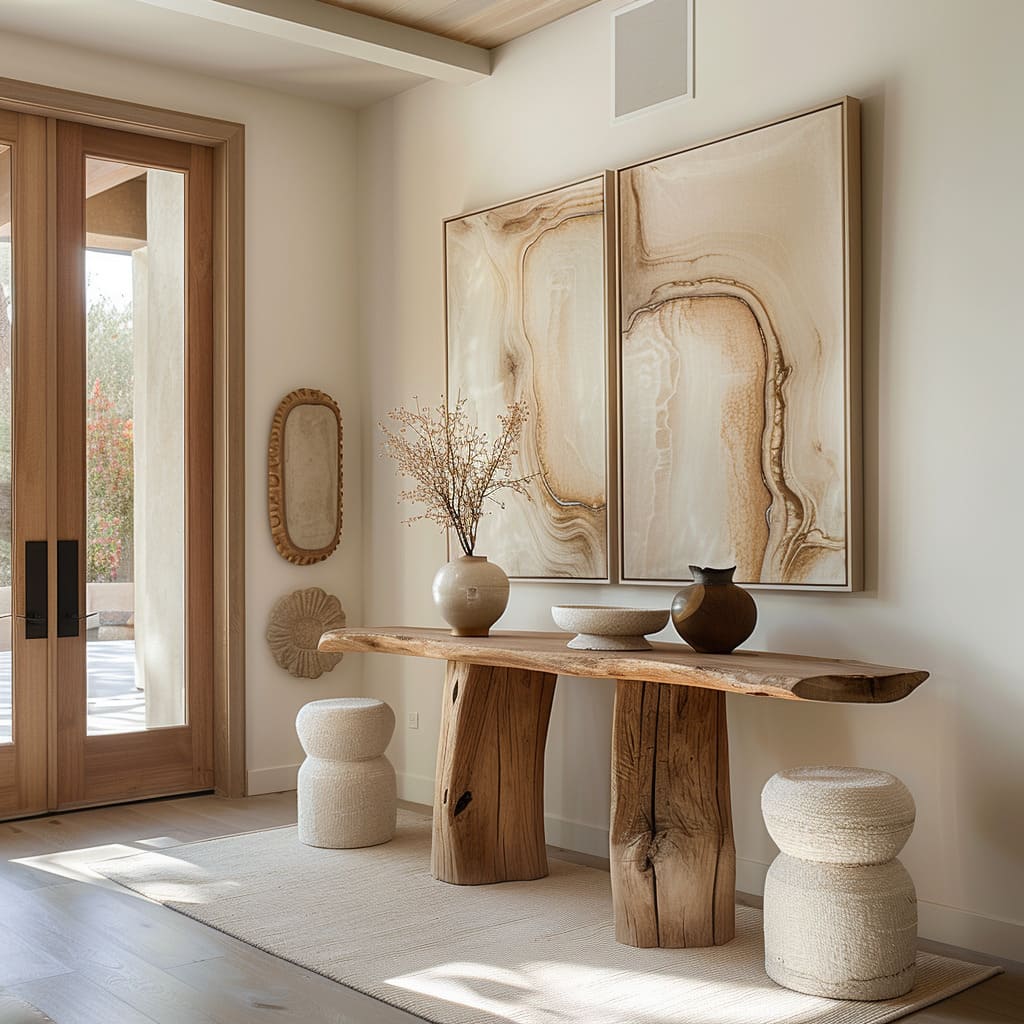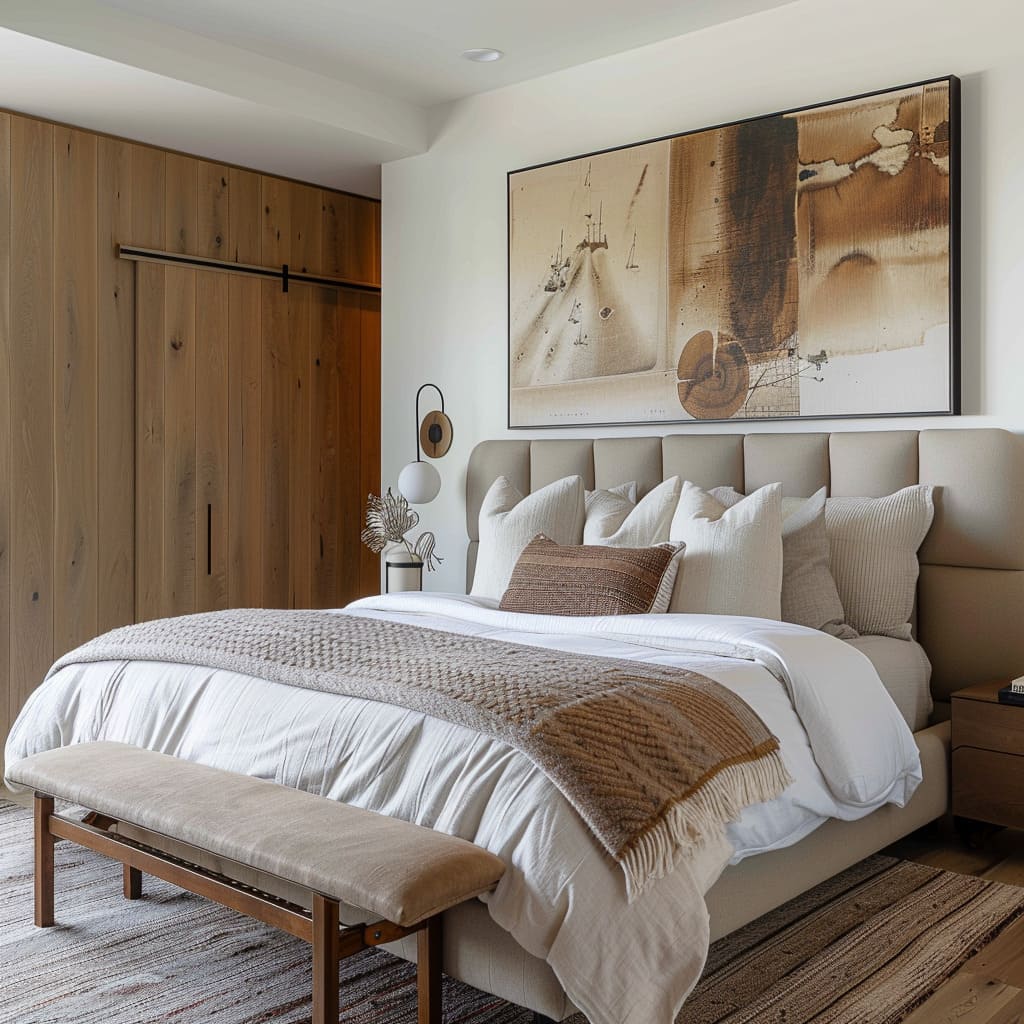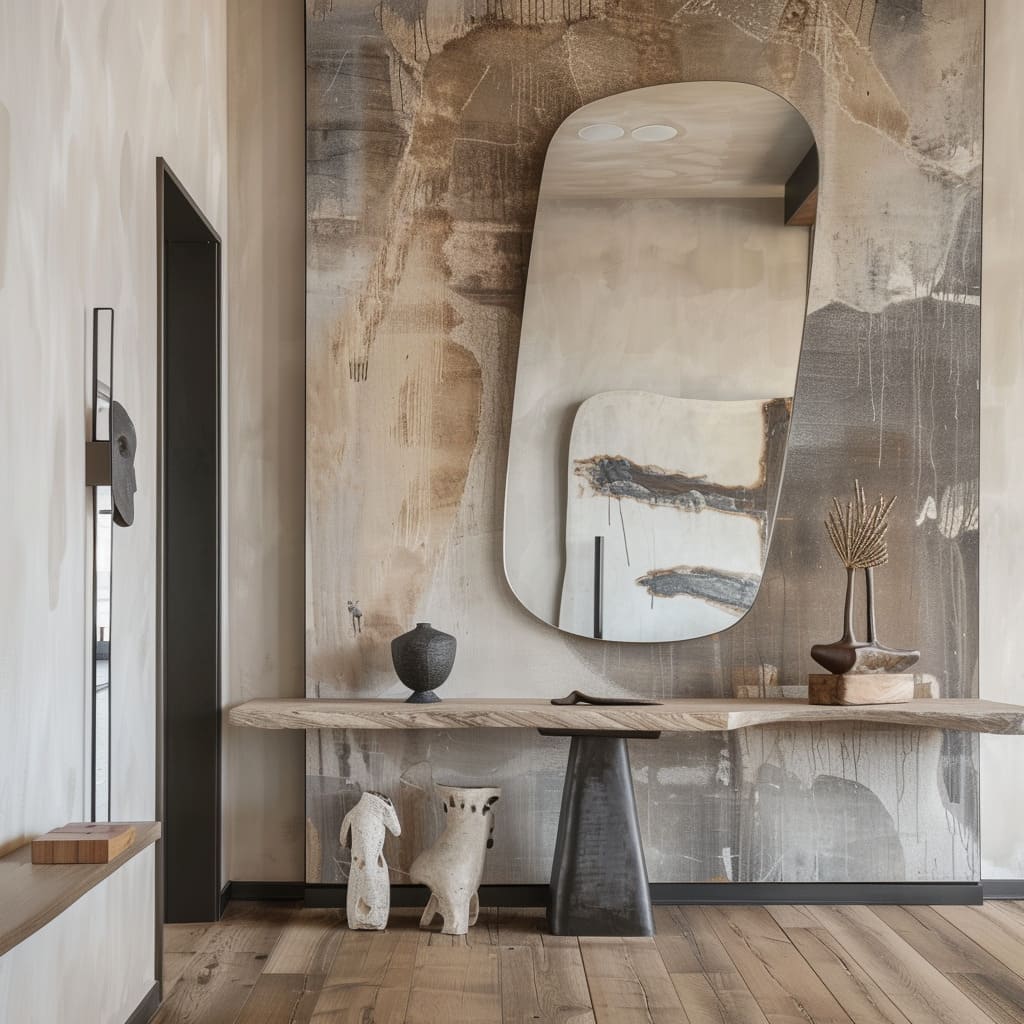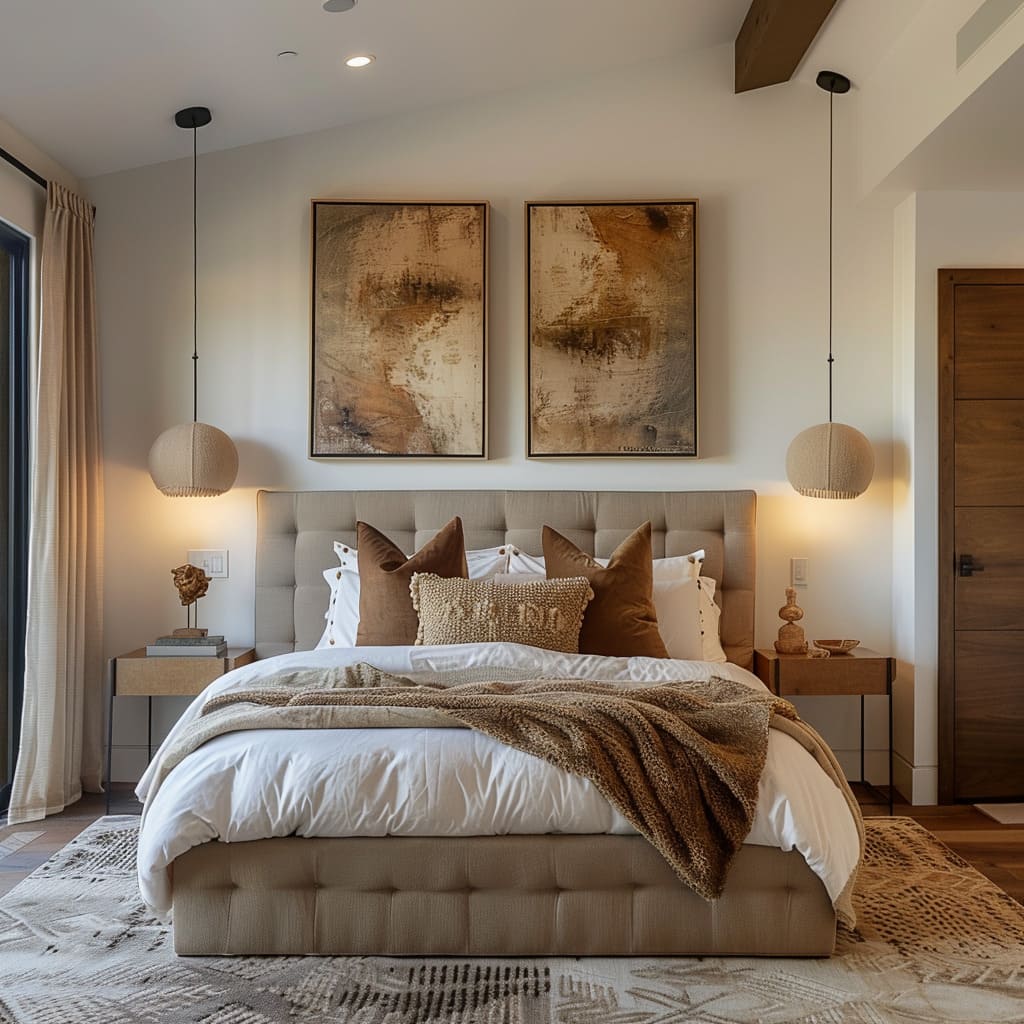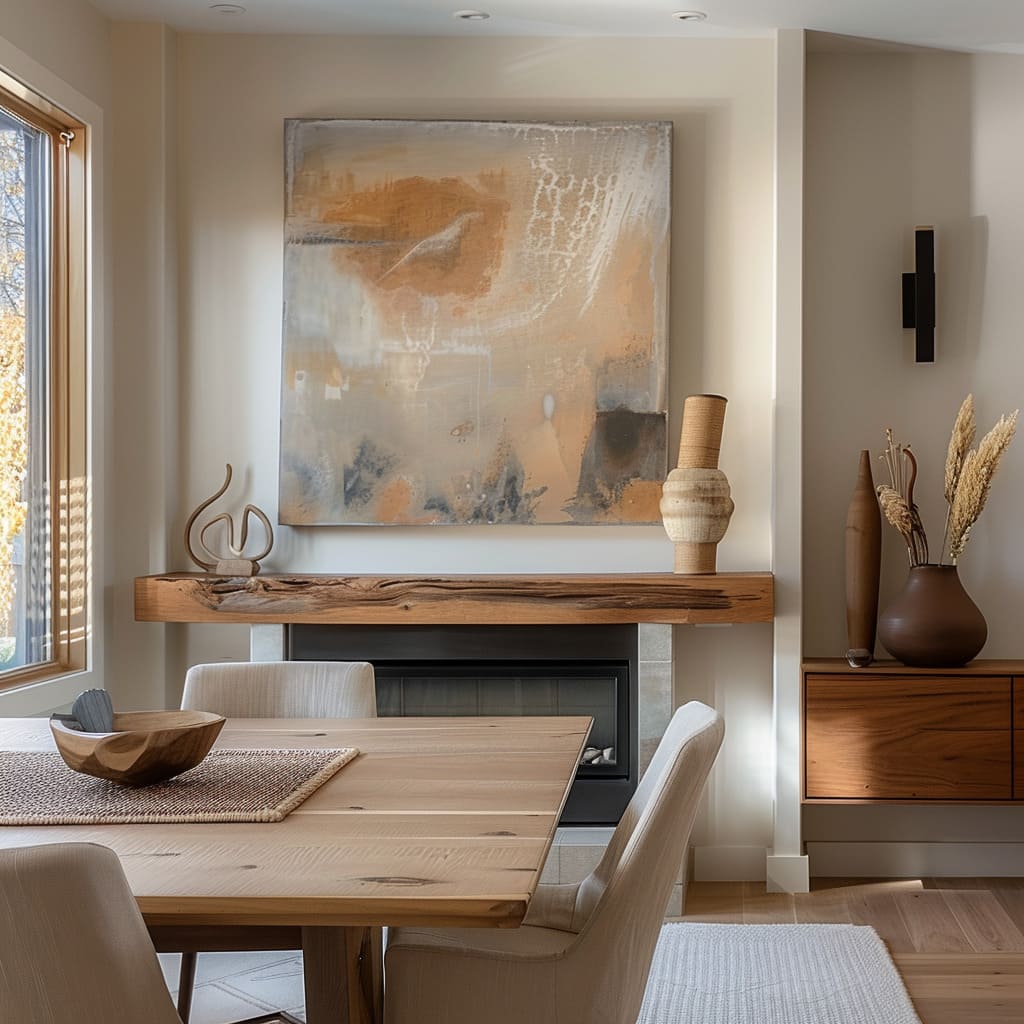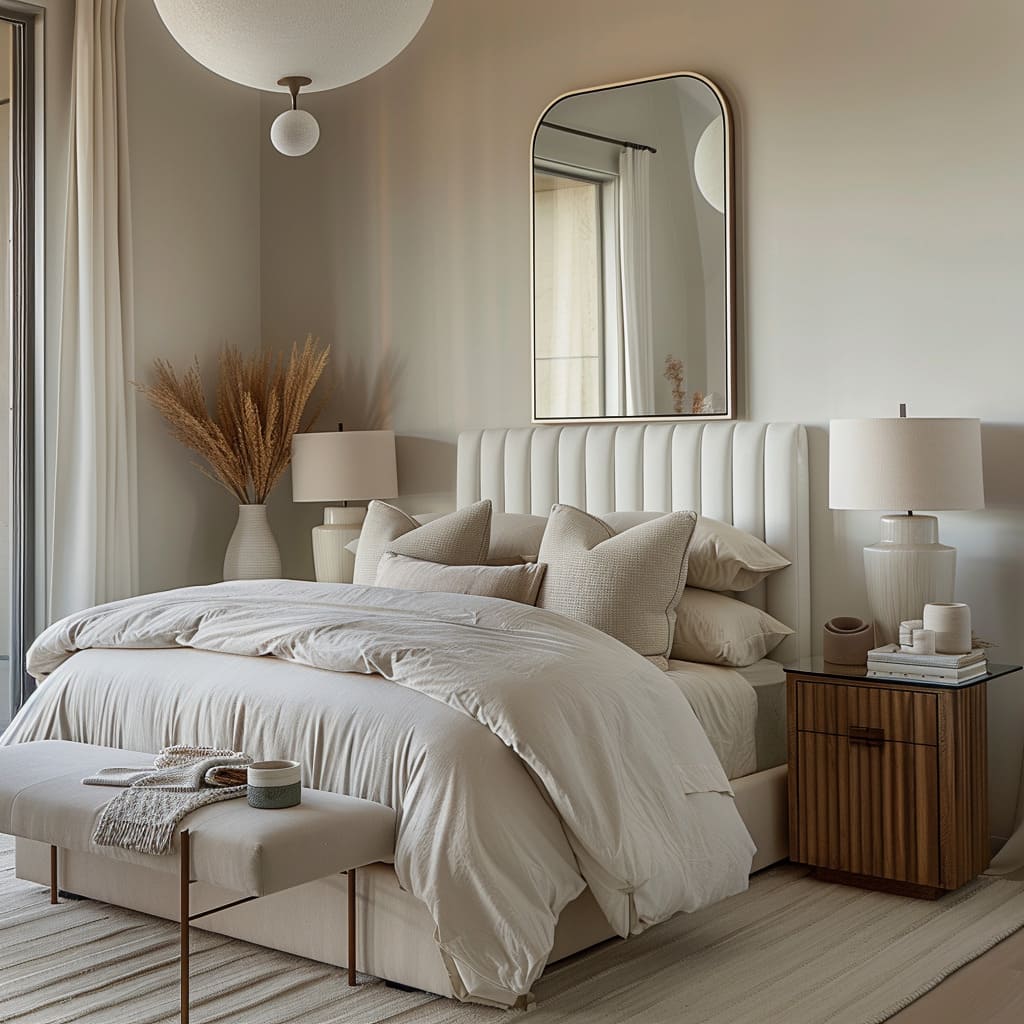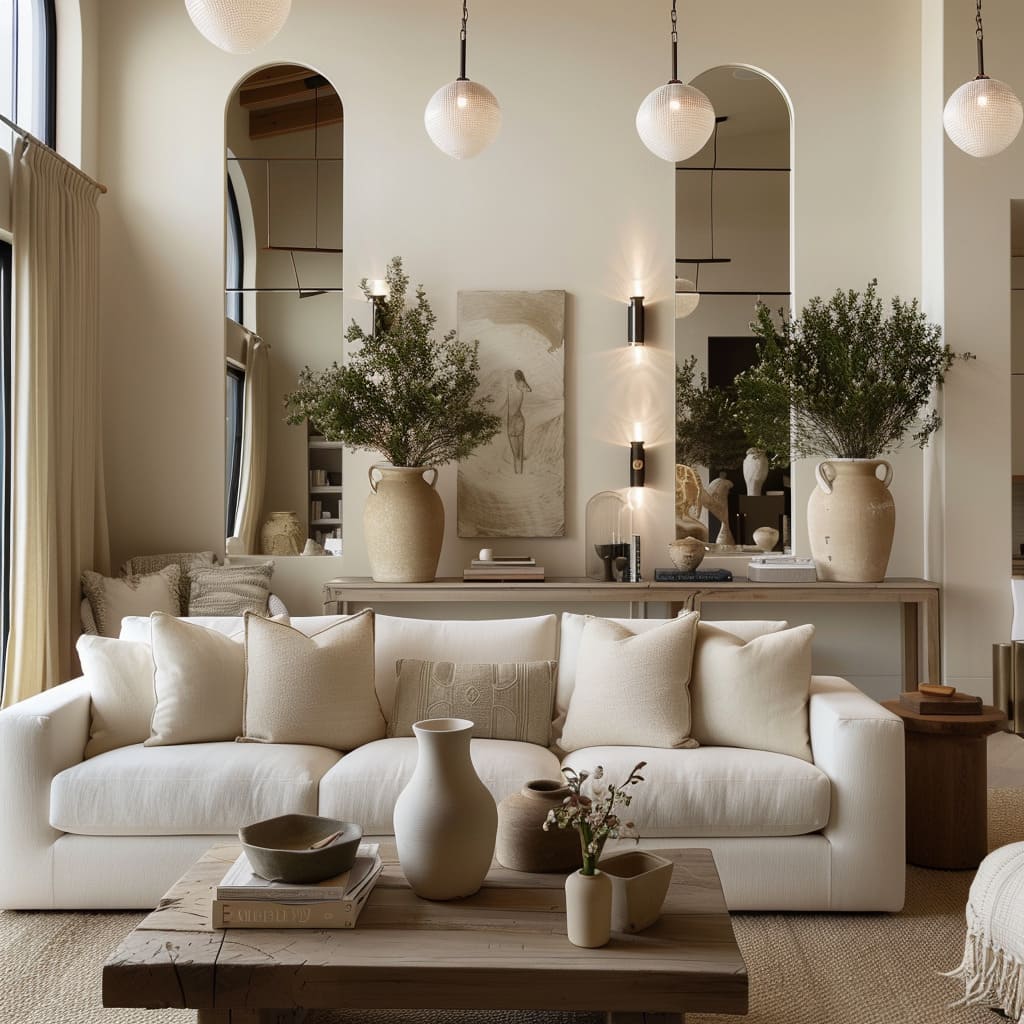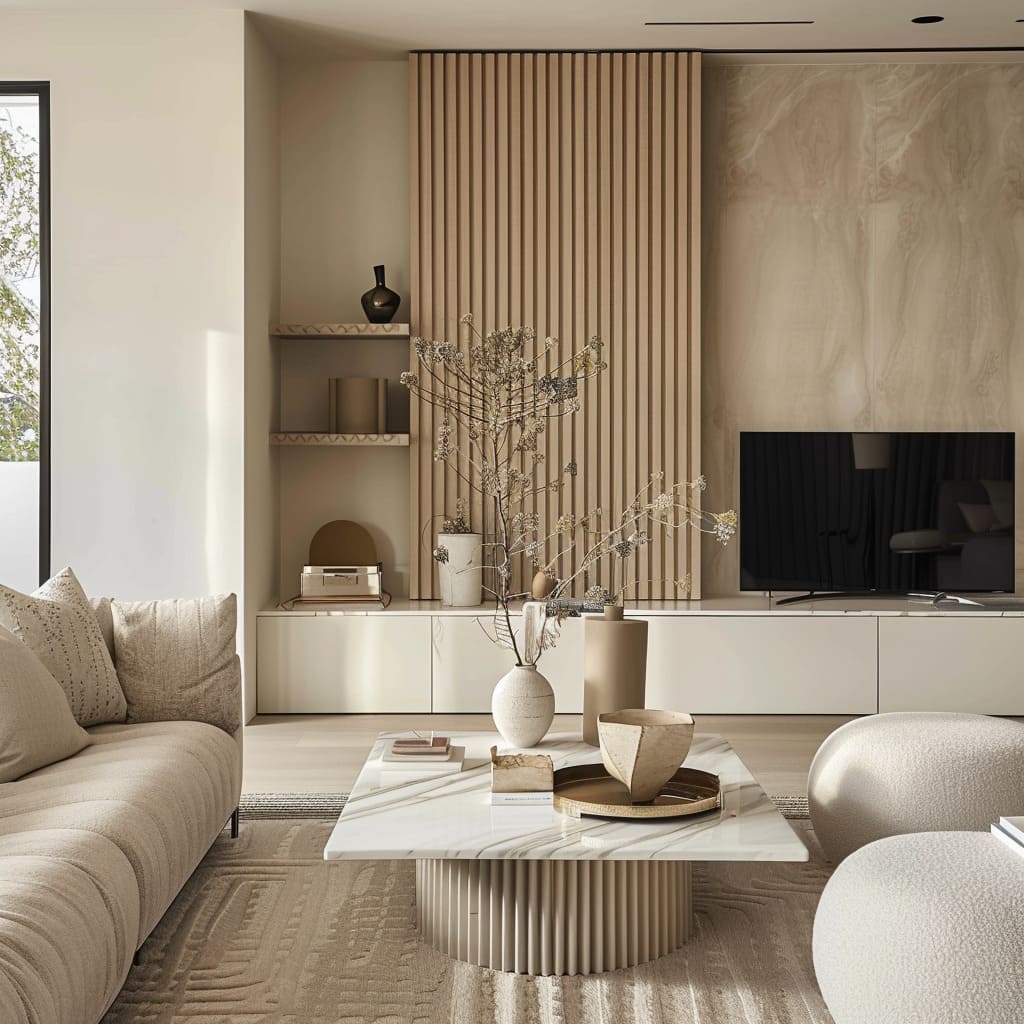Japandi style, a harmonious blend of Japanese minimalism and Scandinavian functionality, offers a unique design philosophy that emphasizes clean lines, neutral color palettes, and an affinity for natural materials. This style is ideal for those seeking a balanced, clutter-free space that fosters tranquility and comfort.
This article explores the key aspects of Japandi design and offers guidance on how to infuse your living space with its distinct aesthetic
The Essence of Japandi Aesthetic
Design Philosophy
Japandi design merges the best of Japanese minimalism—known for its restraint and thoughtful use of space—with the cozy, practical elements of Scandinavian design. This fusion creates environments that are both functional and soothing, where every object has a purpose and aesthetic value.
The philosophy behind this style is to create spaces that promote calm and relaxation, utilizing a less-is-more approach in all aspects of the home
Color Palette
In Japandi interiors, the color scheme plays a crucial role in setting the mood. Soft neutrals like greys, browns, and creams dominate, providing a canvas that both soothes and brightens.
Accents in richer earth tones, such as deep greens and rusty oranges, are used sparingly to add depth and warmth without overwhelming the senses. These colors not only make spaces appear larger but also help to cultivate an atmosphere of calm and focus.
How does the use of natural lighting complement the Japandi design philosophy in enhancing the calming and functional aspects of the space?
The use of natural lighting is a fundamental aspect of the Japandi design philosophy, effectively enhancing both the calming and functional qualities of a space. This design style, which combines the best of Japanese minimalism and Scandinavian functionality, emphasizes the importance of creating a tranquil and purposeful environment.
Natural lighting plays a crucial role in achieving these design goals through several key aspects:
Amplifying Spaciousness and Simplicity:
Natural light helps to make rooms appear larger and more open, which is vital in Japandi interiors where space and simplicity are paramount. The illumination from windows not only highlights the clean lines and uncluttered spaces typical of this style but also enhances the visual flow between indoor and outdoor environments.
This seamless integration helps to maintain a minimalist aesthetic while promoting a sense of freedom and openness within the home.
Enhancing Natural Materials and Textures:
Japandi interiors frequently utilize natural materials such as wood, linen, and ceramics, which possess intrinsic textures and colors that are beautifully highlighted by natural light.
The interplay of light and shadow on these materials can bring out their unique characteristics, adding depth and interest to the space without the need for excessive decoration. This focus on natural beauty supports the Japandi principle of finding elegance in simplicity and appreciating the authentic textures that contribute to a peaceful ambiance
Promoting Well-being and Focus:
Exposure to natural light has well-documented benefits for mental and physical health, aspects that are valued in the Japandi lifestyle. The presence of ample natural light can improve mood, increase productivity, and enhance the overall well-being of the inhabitants.
In a Japandi-styled space, where calm and relaxation are key goals, natural lighting contributes by creating an environment that is conducive to meditation, reflection, and rejuvenation
Sustainability and Energy Efficiency:
Japandi design is not only about aesthetics but also incorporates principles of sustainability and practicality, values shared by both Japanese and Scandinavian cultures. Maximizing natural light reduces the need for artificial lighting, lowering energy consumption and promoting a greener living space.
This alignment with eco-friendly practices further enhances the functional aspect of Japandi interiors, making them not only beautiful but also beneficial for the environment. In essence, natural lighting is not just a design element in Japandi interiors but a pivotal component that enhances the space’s functionality, beauty, and tranquility.
By allowing daylight to penetrate freely into the home, Japandi design leverages natural resources to create a serene, healthy, and sustainable living environment
In what ways do the textural elements of Japandi decor contribute to the tactile experience of the space, and how do they interact with the minimalist color palette to create a layered aesthetic?
The textural elements of Japandi decor play a critical role in enhancing the tactile experience of the space and work in conjunction with the minimalist color palette to create a layered, visually rich aesthetic. This interaction between texture and color in Japandi design adds depth and interest, contributing to an environment that is both visually appealing and comforting.
Here’s a detailed exploration of how these elements interact:
Enhancement of Tactile Sensations:
Japandi interiors prioritize a variety of textures to compensate for the limited color palette. Textures range from the roughness of raw wood to the softness of woven textiles and the smoothness of ceramic finishes.
Each texture invites touch and contributes to a sense of warmth and comfort, making the space more inviting. The tactile experience is heightened by materials such as linen, wool, and other natural fibers, which are often used in upholstery, rugs, and window treatments
Visual Depth and Interest:
While the color scheme in Japandi spaces tends to be muted, the rich textures play a pivotal role in adding visual interest. For instance, a pale wood coffee table might feature a noticeable grain that draws the eye, or a ceramic vase may have a subtly rippled surface that catches the light.
These textural details prevent the minimalist aesthetic from becoming flat or monotonous, adding layers of visual depth that make the space more dynamic and engaging.
Interaction with Light:
Textural elements in Japandi decor also interact beautifully with natural light, which is a key component of the design style.
Light plays across different surfaces, creating shadows and highlights that change throughout the day. This not only brings out the richness of the textures but also adds a living, breathing quality to the space.
Textured surfaces like brushed metal or sandblasted glass can scatter light, contributing to the soft, diffused lighting that is characteristic of Japandi interiors
Balance and Harmony:
The use of texture in Japandi design also helps balance the overall aesthetic, ensuring that the simplicity of the color palette doesn’t lead to a cold or austere environment. Textures add warmth and character, which are essential for creating a welcoming space.
The tactile qualities of various materials can evoke feelings of calm and relaxation, which are fundamental to the Japandi philosophy of creating peaceful, harmonious interiors
Cohesion and Flow:
Textures also contribute to the flow of the space by creating subtle links between different areas. For example, a rough wooden dining table might echo the wooden slats of a nearby wall treatment, or a soft, plush throw on a sofa might match the texture of curtains in an adjoining room.
These textural repetitions help unify the space and guide the eye smoothly from one area to another, enhancing both the functionality and the aesthetic appeal of the environment. In conclusion, the textural elements in Japandi decor are not merely decorative but are integral to achieving the style’s goals of simplicity, natural beauty, and functionality.
They enrich the sensory experience of the space, add visual and tactile interest, and work in harmony with the minimalist color palette to create interiors that are both sophisticated and cozy
How do the functional aspects of furniture design in Japandi interiors influence the daily lifestyle of the inhabitants, especially in terms of promoting mindfulness and intentionality in personal spaces?
The functional aspects of furniture design in Japandi interiors significantly influence the daily lifestyle of the inhabitants, particularly in promoting mindfulness and intentionality in personal spaces. This influence manifests in several profound ways, reflecting the core principles of both Japanese and Scandinavian design philosophies which value simplicity, functionality, and the enhancement of everyday life
Promotion of Clutter-Free Living:
Japandi furniture is designed to be highly functional and often incorporates multiple uses within a single piece, such as beds with built-in storage or benches that also serve as bookshelves. This multipurpose approach encourages a clutter-free environment by reducing the need for excessive furniture, which aligns with the minimalist aspect of the style.
A less cluttered space not only enhances the visual appeal of the home but also reduces stress and promotes a clearer mental state, making it easier for individuals to focus and engage in mindful activities
Encouragement of Intentional Spaces:
Each piece of furniture in a Japandi-styled interior is chosen with careful consideration, ensuring that it serves a purpose and adds value to the space. This intentionality in furniture selection encourages residents to think carefully about what they bring into their home, leading to more thoughtful consumption and a greater appreciation for each item’s role and aesthetic.
This mindful approach to living space can extend to other areas of life, fostering a habit of intentionality and presence in daily activities
Creation of Restful Environments:
The functionality of Japandi furniture also contributes to the creation of tranquil and restorative environments. For example, the use of soft, natural materials and ergonomic designs in seating, bedding, and relaxation areas can significantly enhance comfort and relaxation.
These design choices support the body and soothe the mind, allowing for better relaxation and rejuvenation. This focus on comfort helps individuals to slow down, unwind, and be more present, which is essential for mindfulness
Facilitation of Natural Flow:
Japandi interiors are designed to facilitate a natural flow within the space, with furniture arrangements that promote easy movement and interaction. This thoughtful spatial planning helps in reducing daily frustrations associated with cramped or illogically arranged living areas.
By enhancing the ease of movement, Japandi furniture design indirectly encourages a smoother, more contemplative approach to daily routines, promoting a sense of calm and order
Support for Engagement with Nature:
Often, Japandi furniture is positioned to maximize the engagement with natural surroundings, whether through the placement near windows that offer views of the outdoors or the integration of elements like indoor plants. This connection with nature is integral to mindfulness, as it provides a constant reminder of the natural cycle of life and our place within it.
The strategic placement of furniture to embrace natural light and views can help individuals feel more grounded and connected to the external world. In essence, the functional aspects of Japandi furniture design profoundly impact the daily lives of those who dwell in such spaces, promoting mindfulness and intentionality.
By encouraging a clutter-free, intentional, and tranquil living environment, this design philosophy supports a lifestyle that values the quality of daily experiences, fostering well-being and contentment
Natural Materials in Japandi Interiors
Wood as a Central Element Wood is a central element in Japandi design, favored for its warmth and natural texture. Furniture pieces are often made from oak, ash, or walnut, with a preference for craftsmanship that highlights the material’s natural beauty through simple yet sturdy constructions.
The wood’s visible grain and imperfections are celebrated, adding character and warmth to the space. Incorporating Other Natural Materials Beyond wood, Japandi rooms often incorporate other natural materials like linen, cotton, clay, and stone.
These materials are chosen for their texture and organic quality, contributing to the layered, tactile feel of the design. For instance, soft linen curtains or hand-thrown ceramic vases can add subtle interest and elegance to the minimalist decor
How does the strategic placement of wooden furniture and elements near sources of natural light enhance the visual appeal and functionality of Japandi spaces?
The strategic placement of wooden furniture and elements near sources of natural light significantly enhances both the visual appeal and functionality of Japandi spaces. This thoughtful positioning is crucial in Japandi interiors, where the connection between nature and living spaces is key to the design philosophy.
Here’s how this placement affects both the aesthetics and the practical use of the space:
Highlighting Natural Beauty:
Wood, with its inherent warmth and rich texture, becomes visually more inviting under natural light. The light accentuates the wood’s grain and imperfections, which are celebrated in Japandi design for their natural beauty and character.
When wooden elements are placed near windows or other natural light sources, the varying intensities of light throughout the day dynamically alter how these features are perceived, enhancing their organic appeal and keeping the interior visually engaging
Enhancing Spatial Perception:
Natural light has the ability to make spaces feel larger and more open, which is a key goal in the minimalist approach of Japandi design. By positioning wooden furniture near natural light sources, rooms can appear more expansive.
The light reflects off the wooden surfaces, brightening the area and contributing to a sense of airiness and space, which is fundamental for the calming atmosphere Japandi interiors strive to achieve
Improving Functionality:
In functional terms, placing wooden furniture near natural light sources can improve the usability of the space. For example, a wooden desk or dining table near a window benefits from ample natural light, reducing eye strain and enhancing the comfort of activities like reading, writing, or eating.
This not only makes practical tasks more enjoyable but also supports health and well-being by maximizing exposure to natural light, known for its mood-enhancing properties
Creating a Seamless Indoor-Outdoor Connection:
Japandi interiors often aim to blur the boundaries between inside and outside, creating a harmonious flow that extends the living space into nature. By positioning wooden elements near sources of natural light, especially where views of the outside are clear, there is a stronger connection to the outdoors.
This not only enhances the aesthetic appeal by framing outdoor views with natural textures but also reinforces the tranquil and restorative qualities of Japandi spaces, making nature an integral part of the daily living experience
Sustainable Living:
Utilizing natural light to illuminate spaces during the day reduces reliance on artificial lighting, which aligns with the sustainable practices embraced in Japandi design. Wood, as a sustainable material when sourced responsibly, coupled with natural lighting, underscores the eco-friendly ethos of this style, contributing to an environmentally conscious interior.
Overall, the strategic placement of wooden furniture near natural light sources is more than just an aesthetic choice in Japandi design—it’s a fundamental principle that enhances the space’s beauty, functionality, and connection to the natural world, embodying the style’s commitment to simplicity, sustainability, and well-being
In what ways do the textural contrasts between different natural materials like linen, clay, and wood contribute to the sensory experience and overall atmosphere of a room?
The textural contrasts between different natural materials such as linen, clay, and wood play a significant role in enhancing the sensory experience and overall atmosphere of a room, especially in design styles like Japandi that emphasize natural aesthetics and simplicity. Here’s how these contrasts contribute to the environment:
Visual Depth and Interest:
The variety in textures introduces visual depth and complexity to a space that might otherwise appear too simplistic or flat.
For instance, the rough grain of wood against the smooth surface of a clay vase or the soft, flowing drapes of linen curtains creates a layered visual effect. This interplay of textures keeps the eye engaged and interested, adding subtle dynamism to the decor without the need for bright colors or elaborate patterns
Tactile Diversity:
Japandi spaces are not only meant to be seen but also to be felt. The contrast in textures from different materials like the cool touch of clay, the warm roughness of wood, and the softness of linen invites interaction and touch, enhancing the tactile experience of the room.
This tactile diversity encourages occupants to be more present and connected with their surroundings, fostering a deeper appreciation for the materials and craftsmanship
Enhanced Comfort and Welcoming Atmosphere:
Textures greatly influence the comfort and ambiance of a room. Soft textiles like linen can make a space feel more cozy and inviting, while the solidity of wood provides a sense of stability and warmth.
Clay, often used in decorative elements or functional items like pottery, adds an earthy, grounded feel. Together, these materials work to create an environment that is not only beautiful but also inherently comforting and welcoming
Acoustic Benefits:
Different materials absorb and reflect sound in varying degrees, affecting the acoustics of a room. For example, wood floors and furniture can enhance the room’s acoustics by softening sound, whereas linen curtains can help dampen noise, preventing echoes and creating a quieter, more serene space.
This is particularly important in Japandi design, where a peaceful atmosphere is key.
Psychological Impact:
The use of natural materials and their textural contrasts can also have a significant psychological impact.
Natural materials are often associated with nature and the outdoors, which can help to bring an element of the natural world indoors, reducing stress and enhancing mental well-being. The textural variety ensures that the space remains interesting and stimulating in a subtle way, which can boost mood and overall satisfaction with the environment
Cohesion and Harmony:
While contrasting, the textures of natural materials also need to harmonize with each other to maintain the aesthetic integrity of the space. The way these materials are combined—considering factors like balance, proportion, and color—can influence the overall harmony of the room.
In Japandi interiors, the careful selection and placement of these textures are crucial to achieving a balanced, unified look that feels intentionally curated. In summary, the textural contrasts between linen, clay, and wood significantly enrich the sensory experience and atmosphere of a room.
By carefully integrating these materials, Japandi interiors create spaces that are not only visually appealing and tactilely engaging but also emotionally comforting and acoustically pleasing, all of which contribute to a holistic and satisfying living environment
How do natural materials influence the ambient temperature and acoustics of a room, and what role does this play in the comfort and tranquility of Japandi interiors?
Natural materials play a significant role in influencing the ambient temperature and acoustics of a room, which are key factors in enhancing the comfort and tranquility of Japandi interiors. Here’s how these materials contribute to these aspects:
Temperature Regulation:
Natural materials like wood, stone, and natural fibers have inherent properties that help moderate indoor climates.
Wood, for example, has excellent insulation properties; it can help keep a room warm in the winter by trapping heat and cool in the summer by absorbing humidity. Similarly, stone flooring can help maintain a cool environment during hot weather.
These materials help create a comfortable living environment that adjusts naturally with the seasons, reducing the need for artificial heating and cooling, and contributing to a sustainable living space
Acoustic Improvement:
The acoustic properties of natural materials significantly enhance the tranquility of a space, a crucial aspect of Japandi design. Soft materials like wool, cotton, and linen are excellent at absorbing sound, reducing echo, and softening noise levels within a room.
This is particularly beneficial in minimalist spaces, which might otherwise feel stark and echoic. Wood, with its porous nature, also helps absorb and diffuse sound, contributing to a quieter, more serene living environment.
These materials help prevent sound from bouncing around and create a calm, peaceful atmosphere conducive to relaxation and mindfulness
Enhanced Comfort and Tranquility:
The use of natural materials not only physically regulates temperature and sound but also adds a psychological layer of comfort. There is a natural comfort that comes from being surrounded by organic elements; these materials often evoke a sense of connection to the outdoors and provide a tactile comfort that can be soothing and grounding.
In Japandi interiors, where harmony and tranquility are paramount, the psychological comfort provided by natural materials is just as important as their physical benefits
Sustainable and Healthful Living:
Natural materials are generally more sustainable than synthetic alternatives, aligning with the eco-friendly ethos of Japandi design. These materials often come with fewer chemical treatments, which contributes to healthier indoor air quality.
Good air quality is crucial for comfort and well-being, making spaces not only more pleasant but also healthier to live in.
Role in Japandi Aesthetics:
Beyond their functional benefits, the natural textures and colors of these materials contribute to the overall aesthetic of Japandi interiors.
The visual warmth of wood, the coolness of stone, and the softness of natural fabrics add layers of sensory depth that enhance the visual and tactile appeal of the space. This integration of form and function is key to creating interiors that are not only beautiful but also immensely livable.
In conclusion, natural materials are fundamental in Japandi interiors not only for their aesthetic value but also for their ability to create comfortable, tranquil, and healthful environments. By effectively regulating temperature and acoustics, these materials support a lifestyle that values simplicity, sustainability, and well-being, core tenets of the Japandi design philosophy
Furniture and Layout
Functional Furniture Design Japandi furniture is notable for its functionality and understated beauty. Pieces are selected for their practicality and comfort, with clean lines and a lack of ornamentation.
This minimalist approach ensures that the furniture not only serves a functional purpose but also complements the open, airy layouts typical of Japandi interiors. Spatial Arrangement The layout in a Japandi-style home is carefully planned to foster ease of movement and tranquility.
Spaces are kept open and uncluttered, with furniture arranged to encourage flow and interaction. Each piece is positioned with intention, often allowing for multiple uses, such as benches that provide seating and storage
How does the choice of materials for Japandi furniture contribute to the overall thermal comfort and acoustic quality of the interior spaces?
The choice of materials for Japandi furniture plays a crucial role in enhancing both the thermal comfort and acoustic quality of interior spaces, contributing significantly to the overall atmosphere and functionality of the design. Here’s how these materials impact these aspects:
Thermal Comfort:
Japandi furniture typically features natural materials like wood, which has excellent insulating properties.
Wood can help regulate indoor temperatures by absorbing and retaining heat during colder months and insulating the interior from external heat during warmer months. This natural regulation contributes to a more stable and comfortable indoor climate without the excessive use of heating or cooling systems, thus promoting energy efficiency.
Other materials such as wool and linen, often used in upholstery, also play a part in thermal comfort. Wool, for instance, is known for its ability to regulate temperature, keep moisture at bay, and even improve indoor air quality by absorbing pollutants.
These properties ensure that seating and other upholstered Japandi furniture contribute to a comfortable, warm, and dry environment
Acoustic Quality:
The acoustic environment is greatly enhanced by the strategic use of soft materials in Japandi furniture. Fabrics like cotton and linen in upholstery absorb sound, which reduces echo and noise within a space.
This is particularly beneficial in minimalist spaces, where hard surfaces might otherwise amplify sound. Wood, while generally more reflective than absorptive when it comes to sound, also plays a role in acoustics.
The soft hardwoods commonly used in Japandi furniture can help to diffuse sound, particularly when used in large pieces such as wardrobes or bookcases. This diffusion helps to prevent echoes and soften sound in a room, contributing to the serene and tranquil atmosphere that is a hallmark of Japandi interiors
Harmony and Well-being:
Beyond physical comfort and functionality, the natural materials used in Japandi furniture have a psychological effect on well-being. Being surrounded by natural elements like wood and natural fibers can decrease stress and enhance feelings of calm.
This connection to nature, known as biophilia, is essential in Japandi interiors and is facilitated through the choice of materials that are not only pleasant to touch and see but also beneficial for mental health. In summary, the selection of materials for Japandi furniture is not merely an aesthetic decision but a functional one that influences the comfort, acoustics, and overall health of the living environment.
These materials help create spaces that are not only visually appealing and aligned with nature but also inherently comfortable and peaceful
In what ways do the textural and color contrasts between furniture and decor items enhance the spatial perception in Japandi interiors?
The textural and color contrasts between furniture and decor items play a pivotal role in enhancing spatial perception in Japandi interiors. These contrasts are carefully curated to balance the minimalist aesthetic while adding depth and interest to the spaces.
Here’s how these elements influence the perception of space:
Creation of Visual Depth:
Textural contrasts, such as the combination of rough wooden surfaces with smooth ceramic or soft textiles, create layers in the visual experience. This layering effect adds depth to interiors, making spaces feel more dynamic and interesting.
The varied textures catch light differently, creating subtle shadows and highlights that enhance the three-dimensional feel of the room.
Defining Spaces:
In Japandi interiors, color contrasts are often used subtly to define different areas within an open-plan space without the use of physical barriers.
For example, lighter tones might be used in the living areas to promote a sense of openness and airiness, while darker shades in furniture or accent pieces can delineate a more intimate, cozy corner for reading or relaxation. These color boundaries help in organizing the space visually and functionally, making the environment both versatile and harmonious
Highlighting Architectural Features:
Color and texture contrasts can also be employed to highlight architectural features or pieces of furniture that are focal points within a space. A dark-colored chair against a light wooden wall, or a bright textile draped over a neutral, sleek sofa, draws the eye and emphasizes these features, enhancing the architectural dialogue of the space.
Balancing Scale and Proportion:
The contrasts help in balancing the scale and proportion of the space. Large, expansive areas can feel more grounded and proportionate with the strategic use of darker or textured large furniture pieces, which anchor the space visually.
Conversely, smaller spaces can feel larger and more open with lighter colors and smoother textures that reflect light and give an illusion of more space
Enhancing User Interaction:
Textural variety invites tactile interaction and encourages movement within a space. The human eye naturally follows contrasts, leading one’s gaze around the room.
This not only makes the space more engaging but also encourages physical movement as inhabitants explore these textural and color differences up close.
Supporting the Minimalist Aesthetic:
Despite their use of contrasts, Japandi interiors maintain a minimalist aesthetic by ensuring that these contrasts are harmonious and subdued.
The palette remains restricted to complementary shades, and textures, though varied, are natural and understated. This approach ensures that the space remains calm and uncluttered, true to the Japandi philosophy of simplicity and serenity.
These elements of textural and color contrast are integral in creating a Japandi space that feels balanced, inviting, and aesthetically coherent, enhancing both its functionality and its beauty
How do the proportions and scale of Japandi furniture pieces influence the functionality and aesthetic harmony of small versus large spaces?
The proportions and scale of Japandi furniture pieces are meticulously considered to enhance both functionality and aesthetic harmony, especially when adapting to different spatial dimensions, whether small or large. Here’s how these elements influence interiors:
Functionality in Small Spaces:
In smaller spaces, Japandi furniture is typically designed to be compact and multifunctional, helping to maximize the use of available space without cluttering it.
Furniture with clean lines and smaller proportions is chosen to fit neatly into limited areas, serving multiple purposes where possible. For example, benches might double as storage units, or coffee tables might include shelves underneath.
This not only saves space but also maintains the minimalist and uncluttered ethos of Japandi design, ensuring that even small rooms feel open and airy
Aesthetic Harmony in Large Spaces:
In larger spaces, the scale of Japandi furniture can be increased to ensure that the room does not feel sparse or under-furnished. Larger pieces, such as expansive sofas or robust dining tables, help fill the space adequately while adhering to the principle of minimalism.
The use of appropriately scaled furniture maintains aesthetic harmony by proportionately balancing the volume of the room with sizeable yet simple furniture pieces, ensuring the space feels cohesive and thoughtfully curated.
Visual Balance and Cohesion:
The scale and proportions of furniture also play a critical role in maintaining visual balance and cohesion in a room.
In Japandi interiors, it’s important that no single piece of furniture overwhelms the space. Even in larger areas, furniture is scaled to harmonize with other elements in the room, such as large rugs or extensive shelving units, creating a balanced visual impact that feels neither too empty nor too crowded
Enhancing Spatial Flow:
Properly scaled Japandi furniture facilitates better spatial flow, essential in both small and large interiors. In compact rooms, furniture that is too large can obstruct movement, making the space feel cramped and less functional.
Conversely, in large rooms, small pieces might get lost, making the space feel disjointed. By scaling furniture correctly, Japandi design ensures that there is a smooth flow of movement and a strong sense of connectivity throughout the space.
Adaptability to Room Function:
The functionality of each room is also considered when choosing the scale of furniture. In areas that require more movement, such as kitchens or hallways, even large spaces might benefit from more streamlined furniture to keep the area clear and functional.
In places designed for rest or gathering, such as living rooms, larger, more robust furniture can be used to enhance comfort and accommodate more people
Support for Minimalist Aesthetics:
The careful consideration of scale and proportion in Japandi furniture supports the minimalist aesthetics of the style. Furniture pieces are designed to be visually appealing but not overpowering, supporting the overall design narrative of simplicity and natural beauty.
This ensures that the furniture itself is a testament to minimalist design, using space and proportion to create a serene and inviting atmosphere. In summary, the proportions and scale of Japandi furniture are integral in enhancing the functionality and aesthetic harmony of any space.
By carefully considering these elements, Japandi interiors achieve a balance that is both practically efficient and visually tranquil, regardless of the room’s size
Decorative Elements in Japandi Design
Art and Decor Artwork in Japandi interiors typically reflects the connection to nature and simplicity. Pieces are chosen for their organic shapes and subdued colors, complementing rather than dominating the space.
Decorations are minimal and meaningful, with an emphasis on handmade and artisanal items that bring a sense of authenticity and calm. Lighting and Ambiance Lighting in Japandi design is soft and diffused, used to enhance the peaceful and inviting quality of the rooms.
Fixtures are often made from natural materials and designed with simplicity in mind, supporting the overall aesthetic without becoming focal points themselves
Bringing Japandi into Different Rooms
Bedroom Design In the bedroom, Japandi style promotes rest and relaxation through the use of soft textiles, comfortable bedding, and soothing colors. The furniture is minimalist yet functional, with clean lines and natural materials that invoke calm.
Bathroom and Living Areas In bathrooms, the Japandi style combines elegance with natural elements, using wooden accents and stone tiles to create a spa-like environment. Living areas follow the same principles, with a focus on open space, natural light, and a connection to the outdoors, facilitated through large windows and glass doors
Conclusion Adopting Japandi style in your home means embracing a lifestyle that values simplicity, natural beauty, and functionality. This design aesthetic can transform your living space into a sanctuary that not only looks beautiful but also supports your wellbeing and peace of mind.
